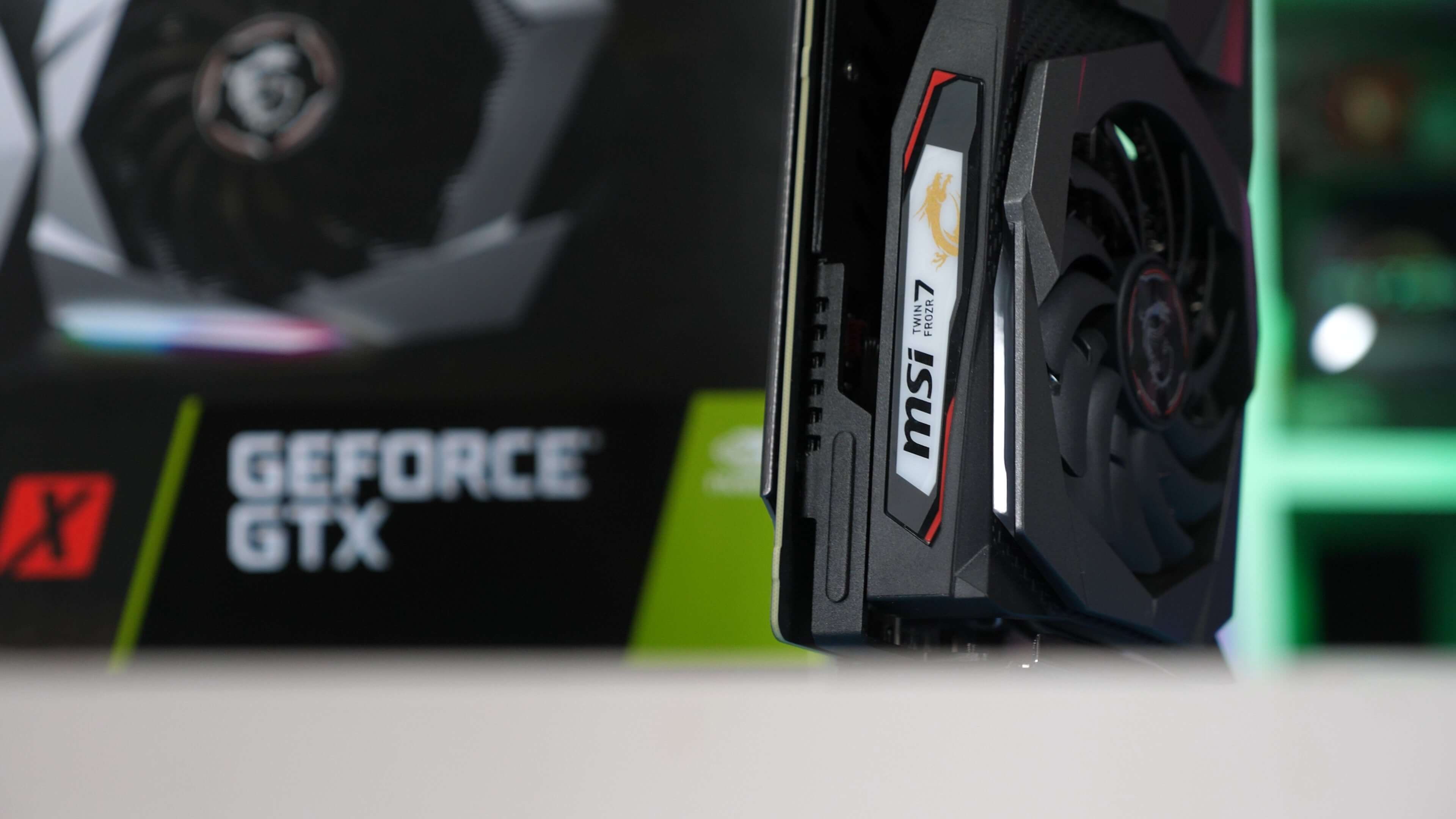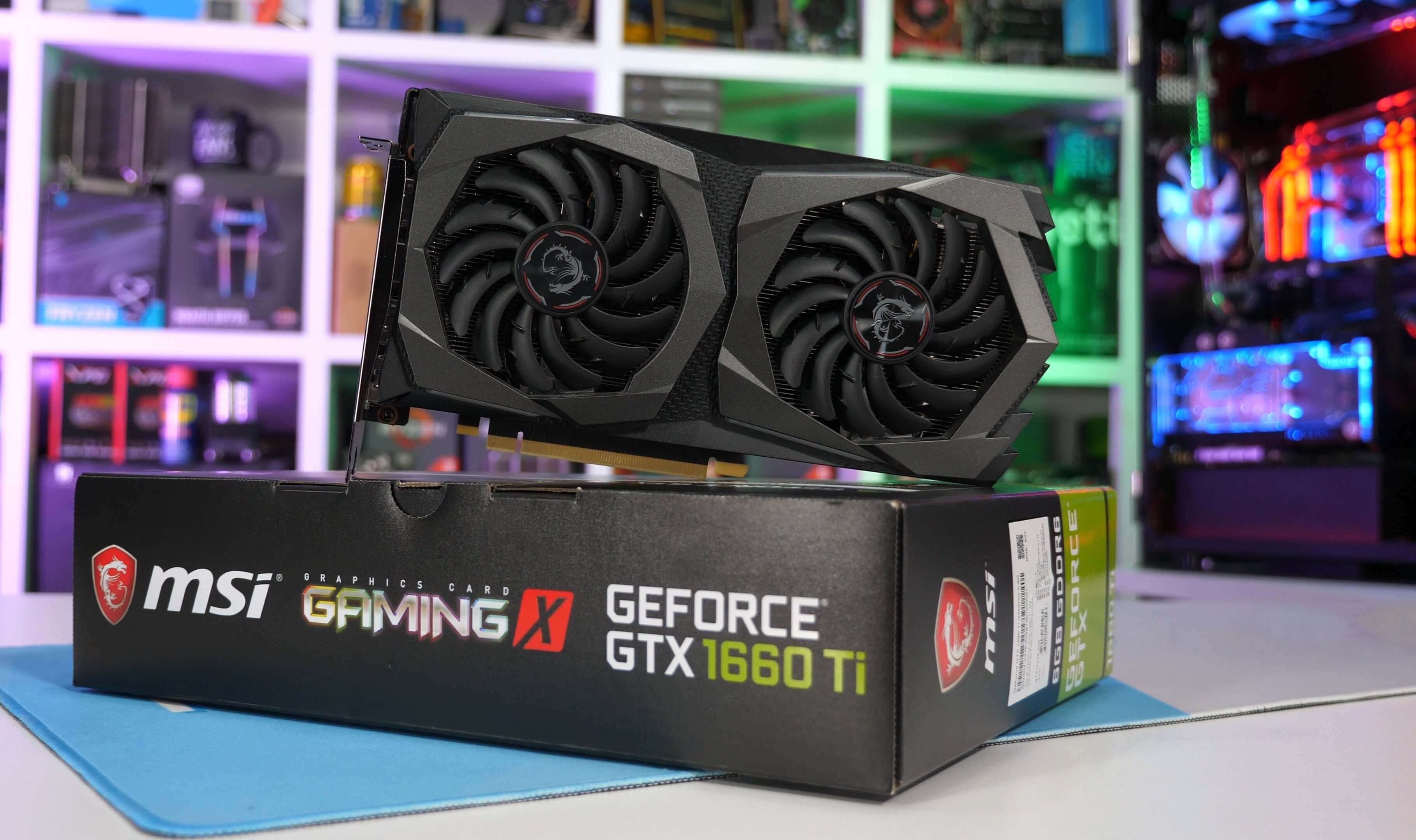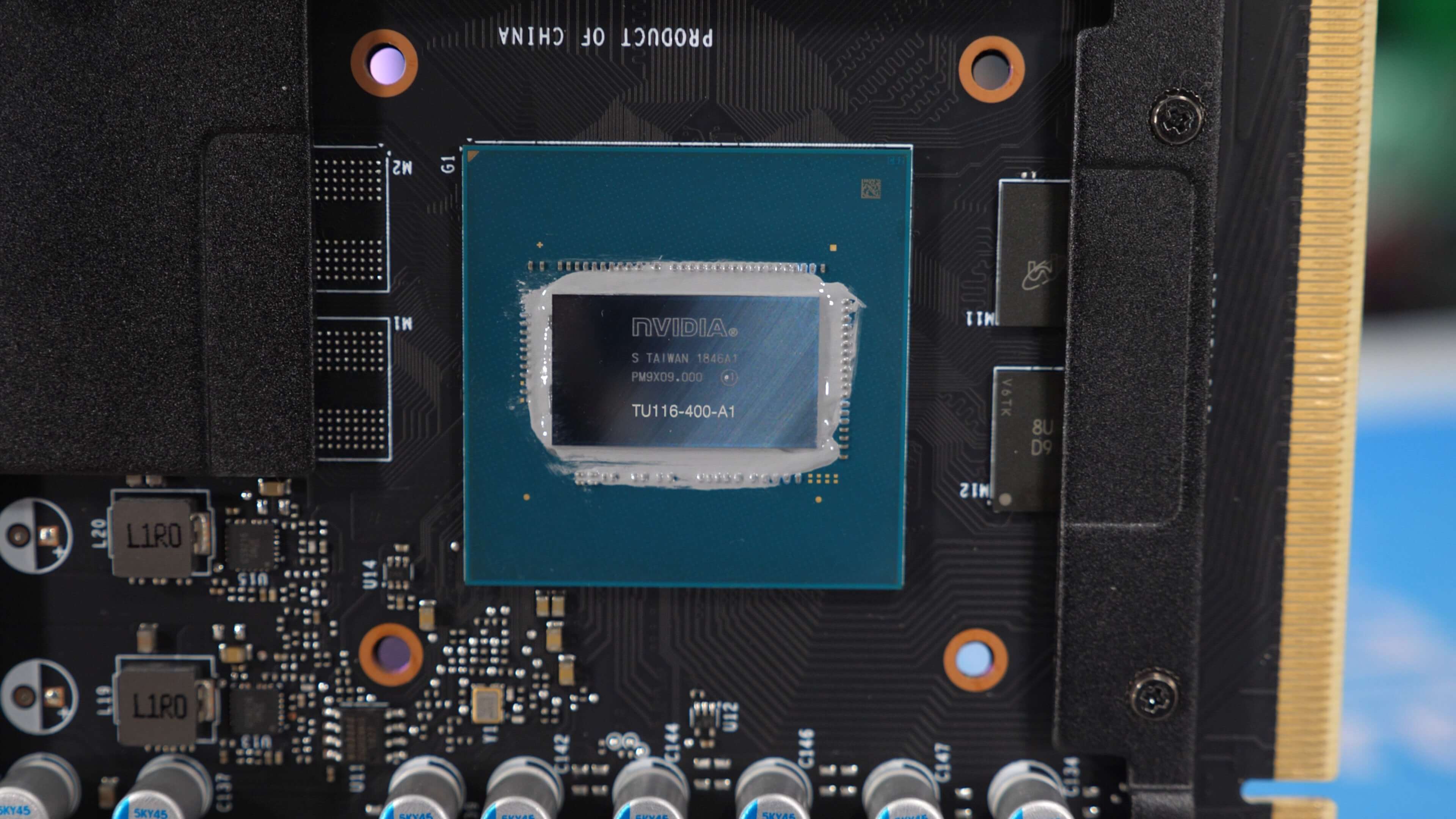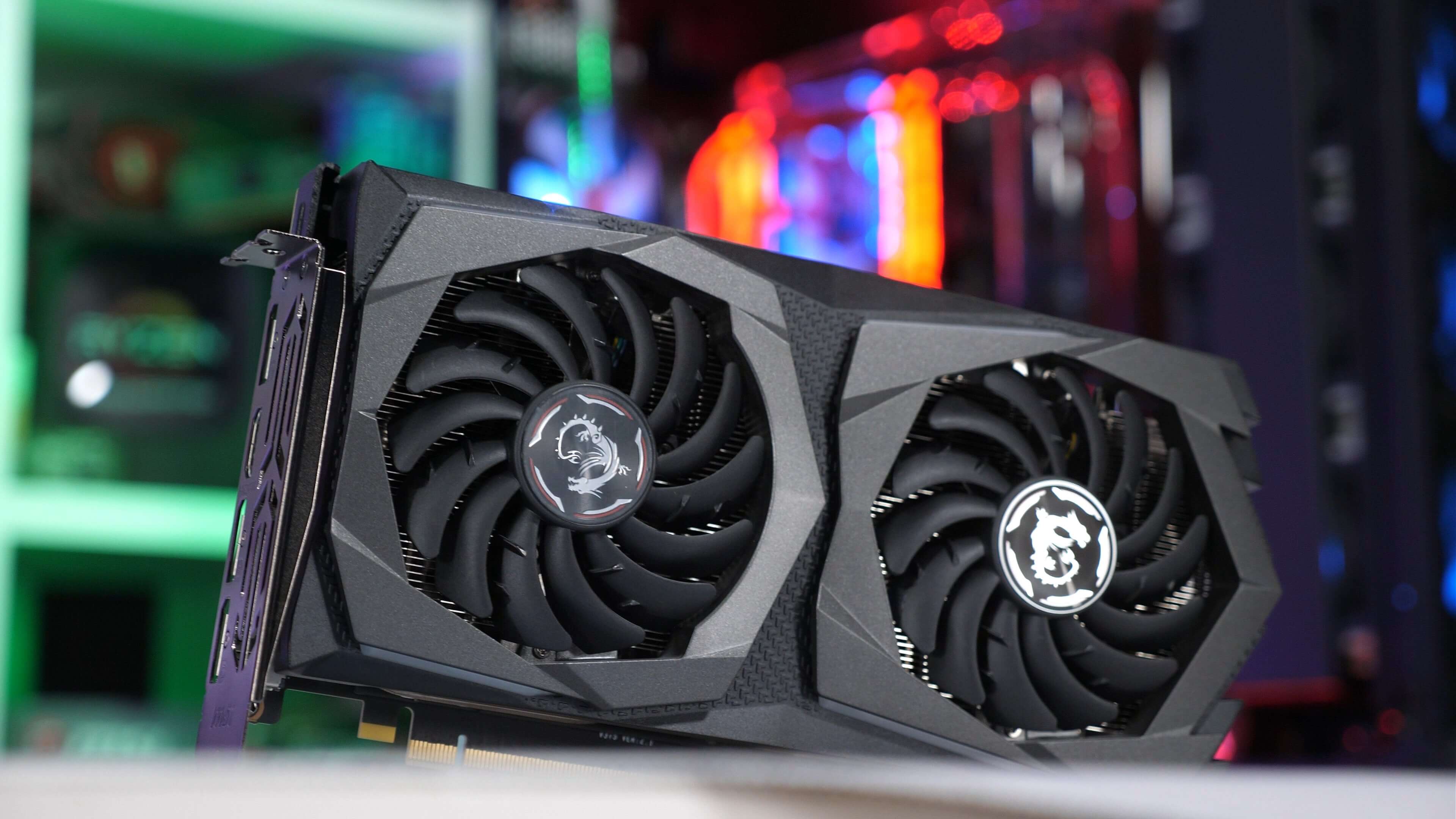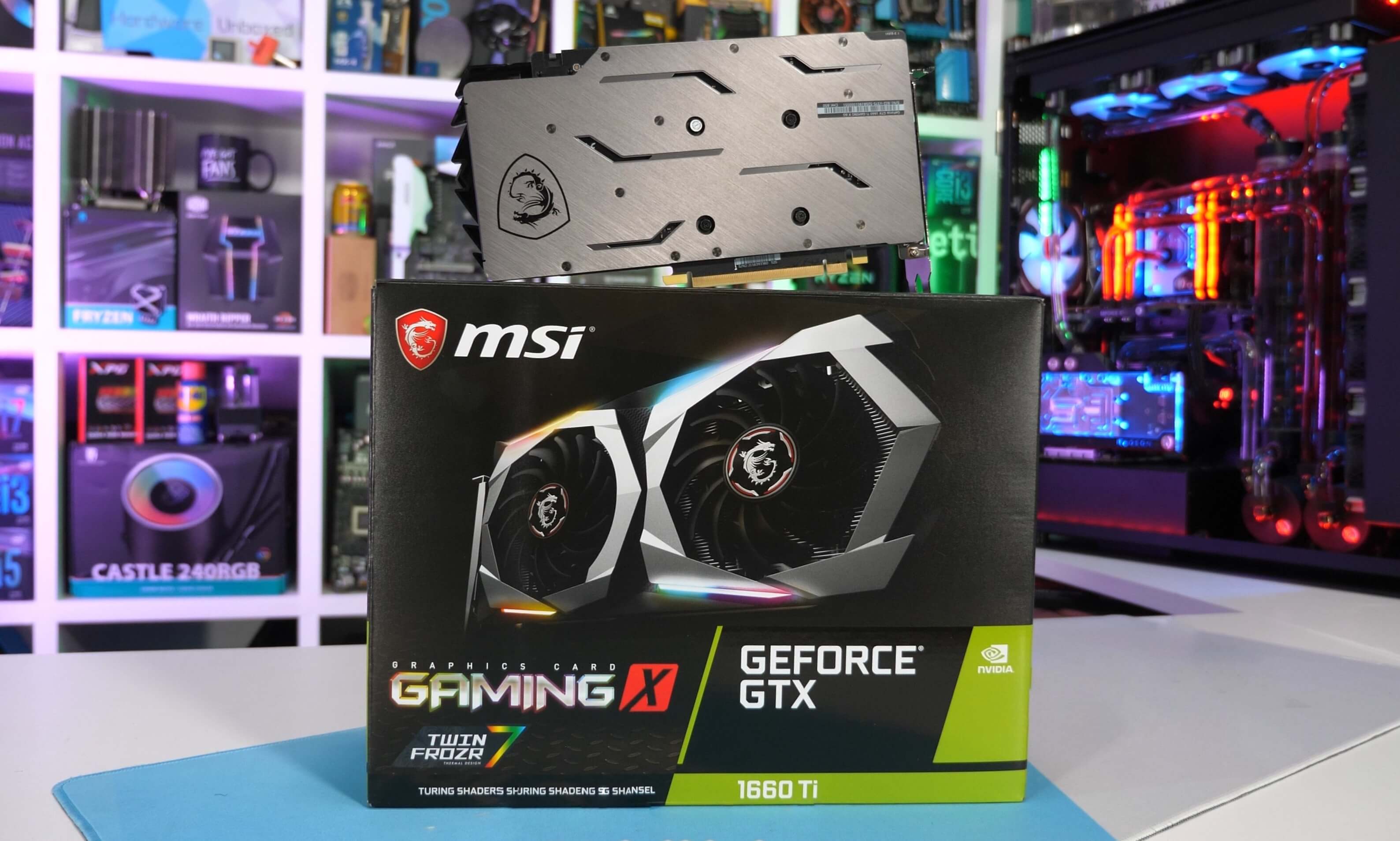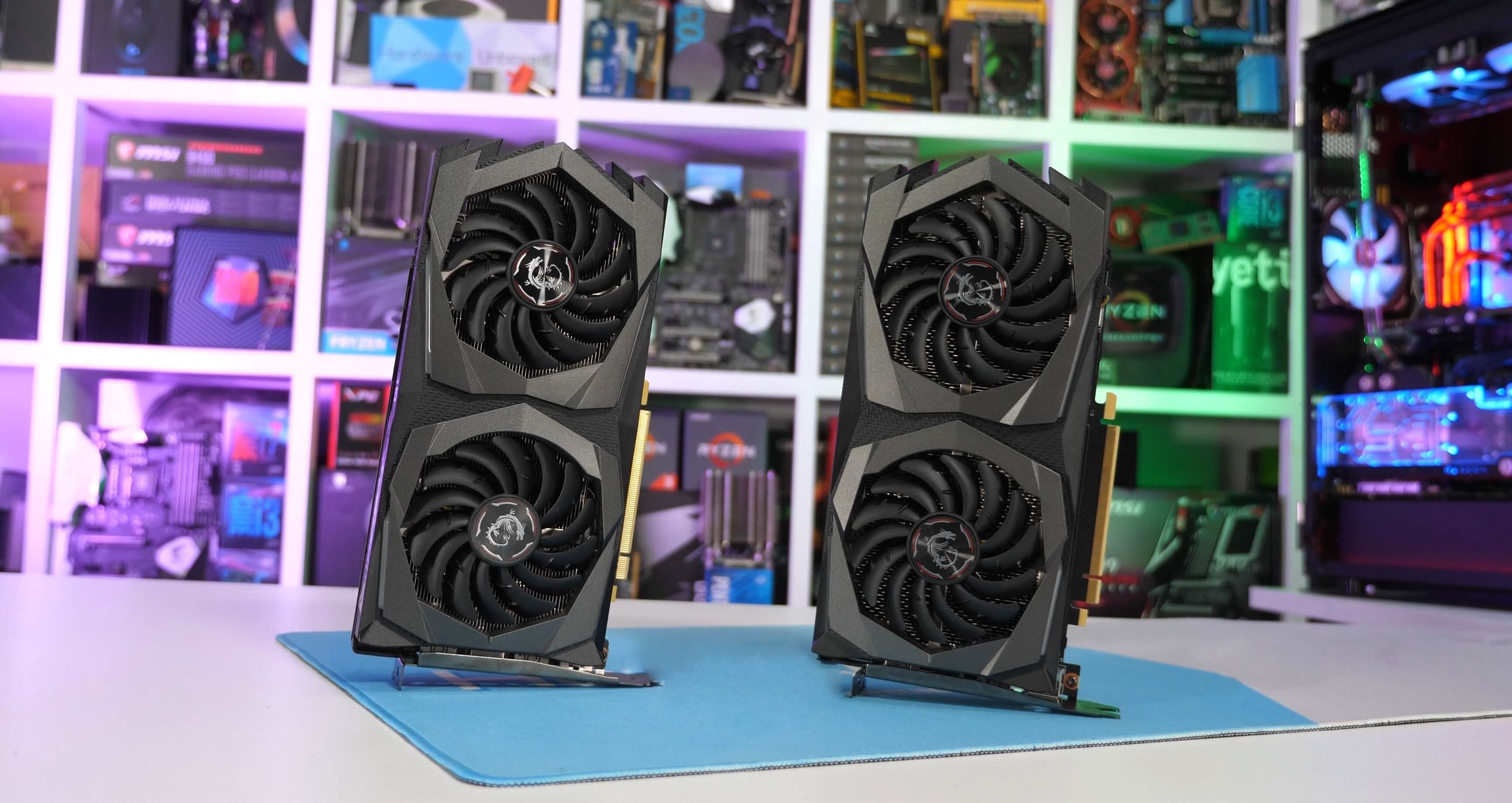Nvidia's latest attempt to excite gamers arrives in the form of a new mid-range GPU with no RTX features on board. The new GeForce GTX 1660 Ti comes as no surprise as it's been widely rumored for some time and most recent leaks were so detailed they virtually confirmed its existence, down to the exact specs and pricing.
And while Nvidia has been pushing the more expensive RTX series as the holy grail for gamers, the reality has been a whole lot less miraculous. Then again, this is akin to what we and many others were asking for: a cut down Turing GPU that trims off the fat. After all, RT cores and Tensor cores are of no value on a mid-range part.
We doubt many of you will miss the ability to enable ray tracing or DLSS anyway, so by dropping these architectural features, Nvidia is able to offer a sub-$300 Turing GPU. However we still get the new SM units featuring dedicated cores for processing FP32 and integer operations simultaneously, and FP16 processing at double the rate of FP32, while also including the latest advancements in programmable shading. The new SM units also feature enhanced caches for increased capacity and bandwidth.
Compared to the RTX 2060, the GTX 1660 Ti packs 25% fewer CUDA cores, but because it also drops the RT and Tensor cores the die is 36% smaller. When compared to the Pascal-based GTX 1060 6GB, the 1660 Ti die is 42% larger, but only packs 20% more CUDA cores. But as we just mentioned, those cores have been upgraded and are now much wider.
The new GTX 1660 Ti also comes with 6GB of GDDR6 memory clocked at 1500MHz for a DDR clock of 6 GHz, and a data rate of 12 Gbps. Using a 192-bit wide memory bus, that results in a peak throughput of 288.1 GB/s which is a 14% reduction in bandwidth when compared to the RTX 2060, but 13% higher than the GTX 1070 and 50% more than the 1060.
With those kind of specs, we're expecting the 1660 Ti to offer GTX 1070-like performance at the designated $280 price point, which would be good news for gamers.
For testing we'll be looking at performance in a dozen titles. As we get some extra time for running more tests, we'll run our full suite of 30+ game benchmarks. The focus of this review will be on 1080p and 1440p performance, using our Core i9-9900K test system clocked at 5 GHz with 32GB of DDR4-3200 memory. We used Game Ready 418.91 WHQL drivers for the GeForce GPUs tested and Adrenalin 2019 Edition 19.2.2 for the Radeon GPUs.
Benchmarks
First up we have Shadow of the Tomb Raider and here the GTX 1660 Ti looks impressive, matching the GTX 1070 Ti with 87 fps on average at 1080p. This allowed it to match Vega 56 and therefore destroy the RX 590 by almost 40%. It remained lethal at 1440p as well, again matching the GTX 1070 Ti and beating the RX 590 by an impressive 41% margin.
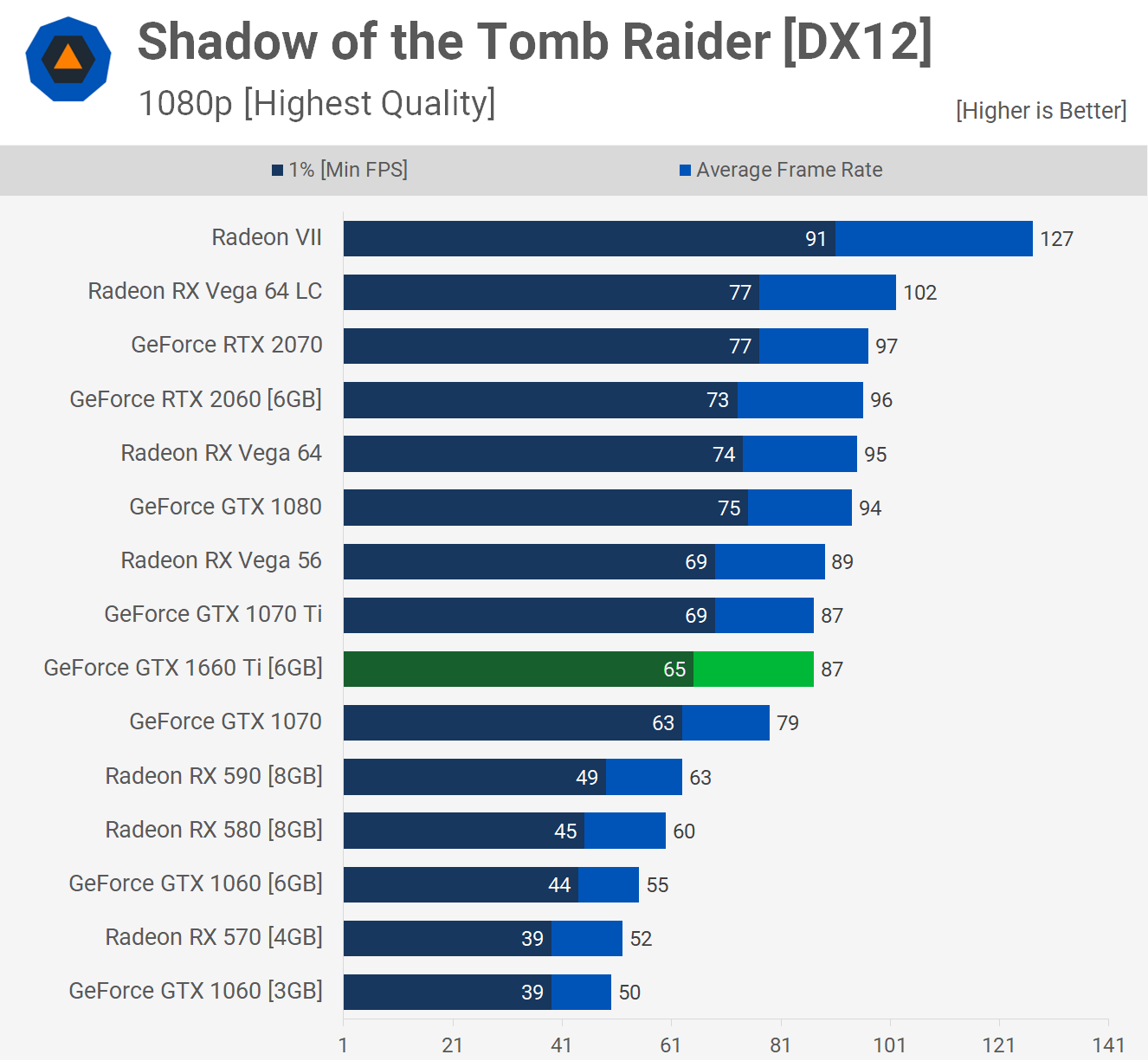
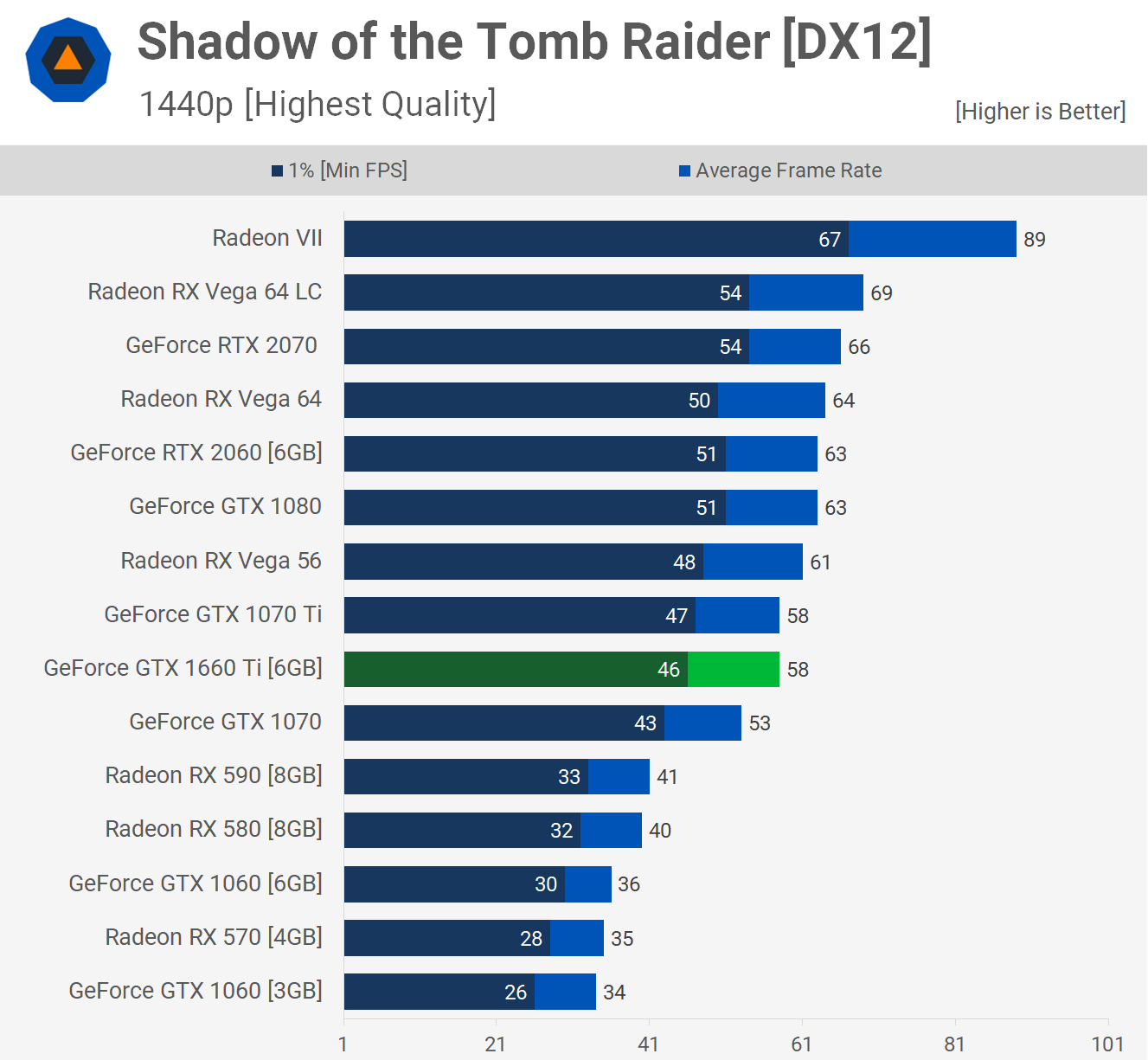
Forza Horizon 4 was actually one of the first games we benchmarked and we were shocked to find the GTX 1660 Ti so close to the RTX 2060. We've seen already that Turing GPUs aren't much faster than their Pascal counterparts in this title, and in the case of the RTX 2070 it's actually a little slower than the 1080.
The GTX 1660 Ti had no trouble keeping up with the GTX 1070 and as a result was just 5% slower than the 2060.
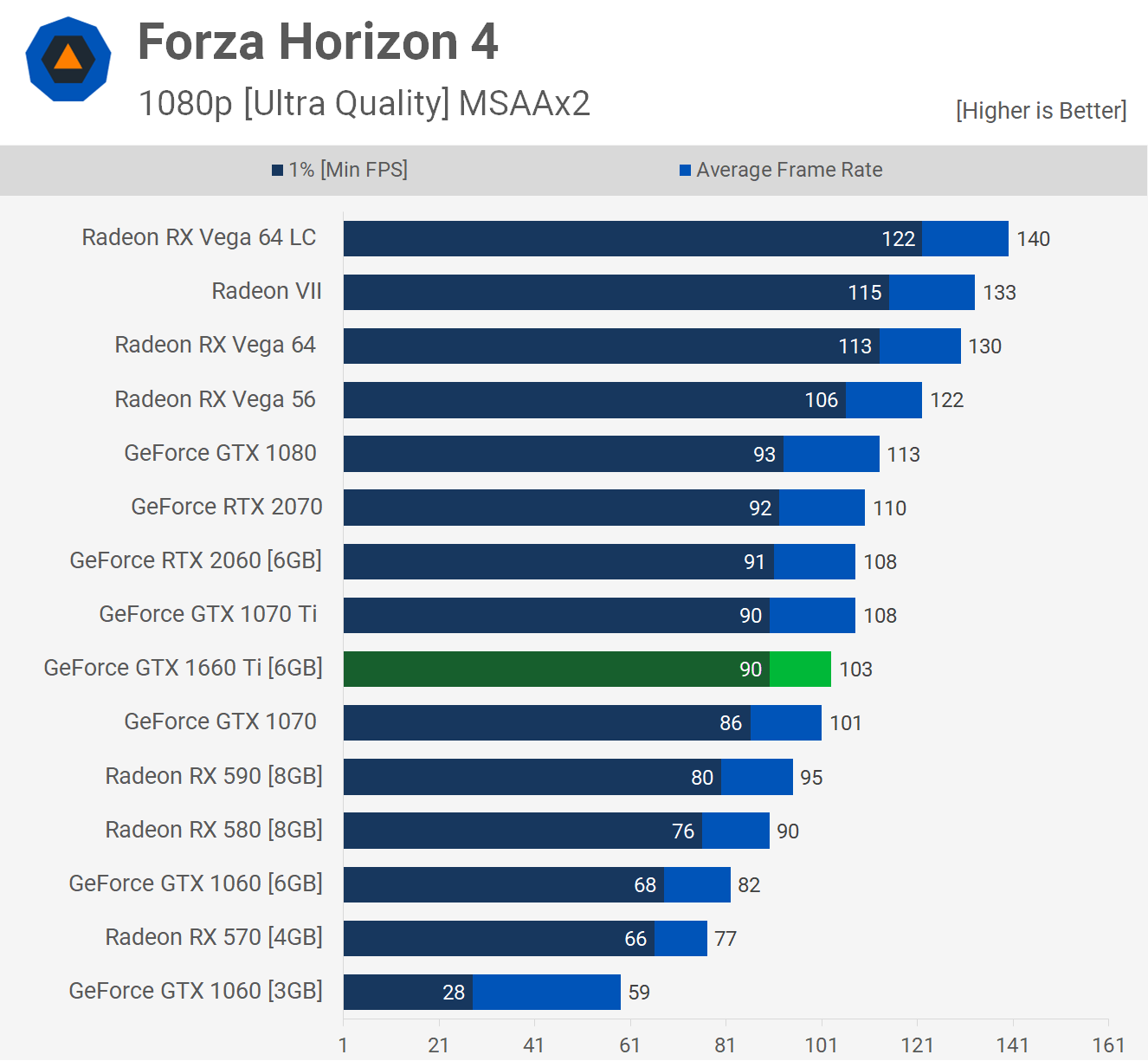
We see the same trends at 1440p. Here the 1660 Ti was just a single frame slower than the 2060, we don't expect we'll see many more results like this though.
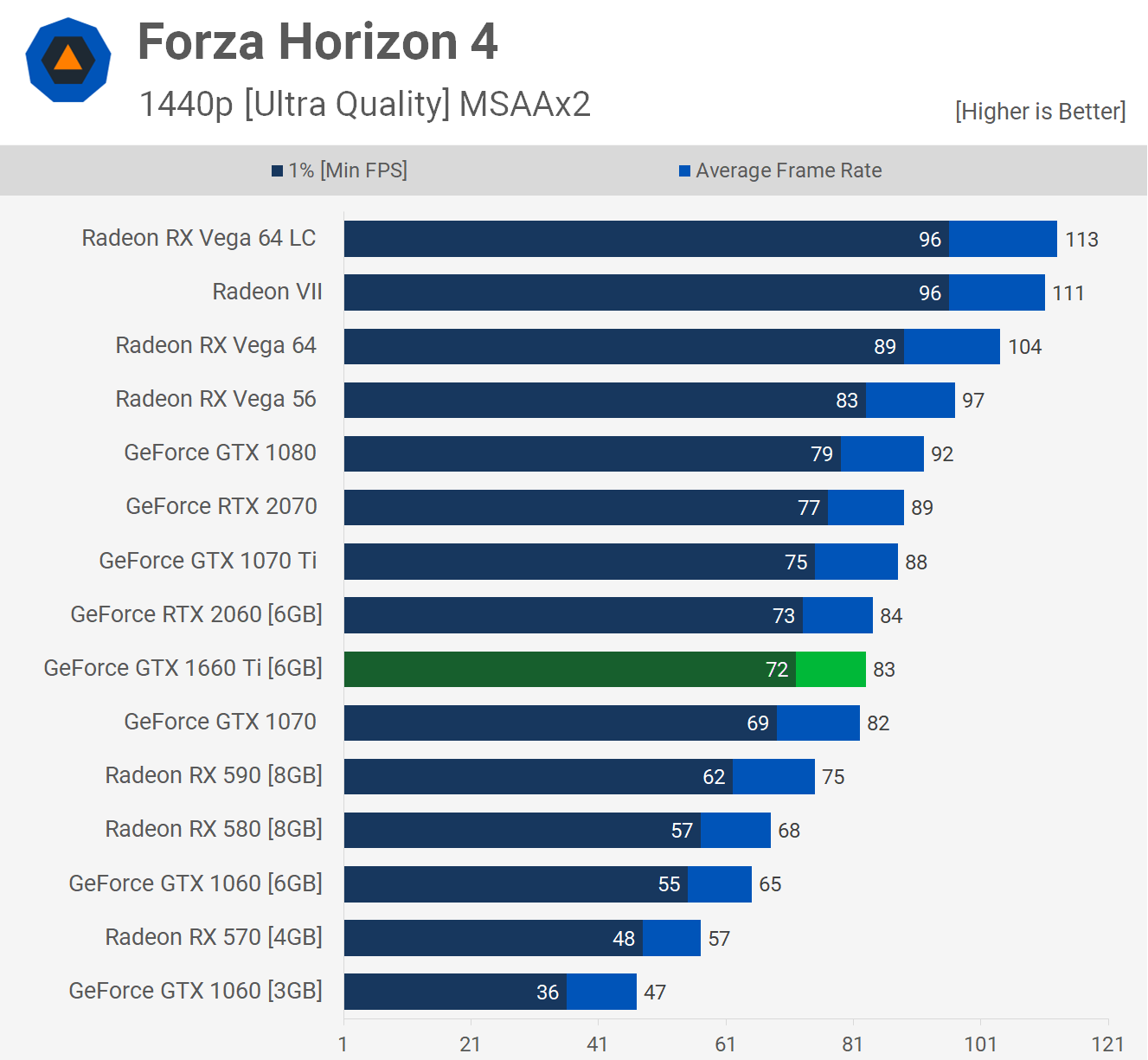
Keeping frame rates above 60 fps in Just Cause 4 certainly isn't easy, but even so the GTX 1660 Ti is now by far the best sub $300 GPU in this title, averaging 73 fps at 1080p, making it 14% faster than the RX 590.
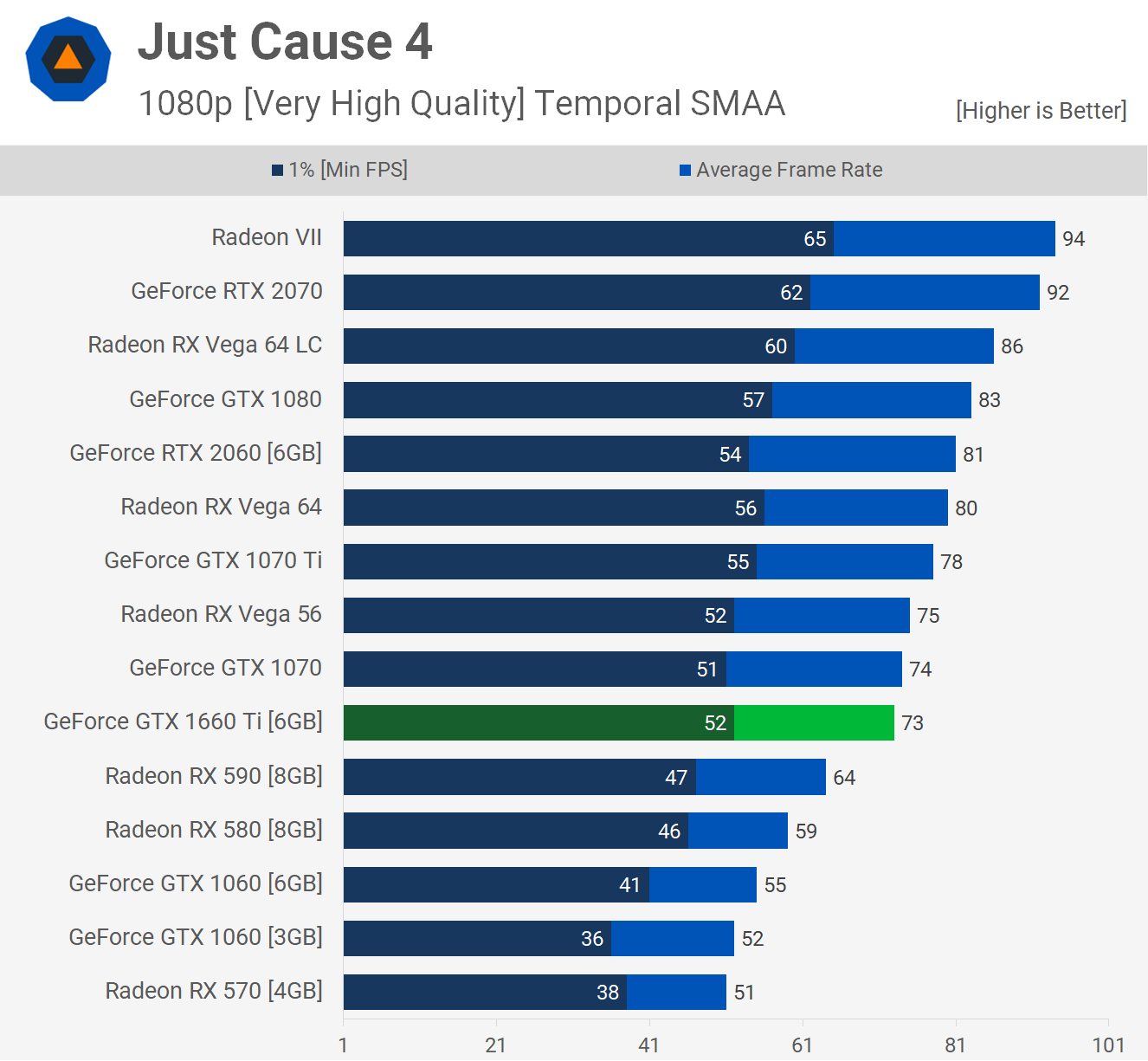
Similar margins are seen at 1440p. The 1660 Ti matches the GTX 1070 and this means it was just a few frames slower than Vega 56.
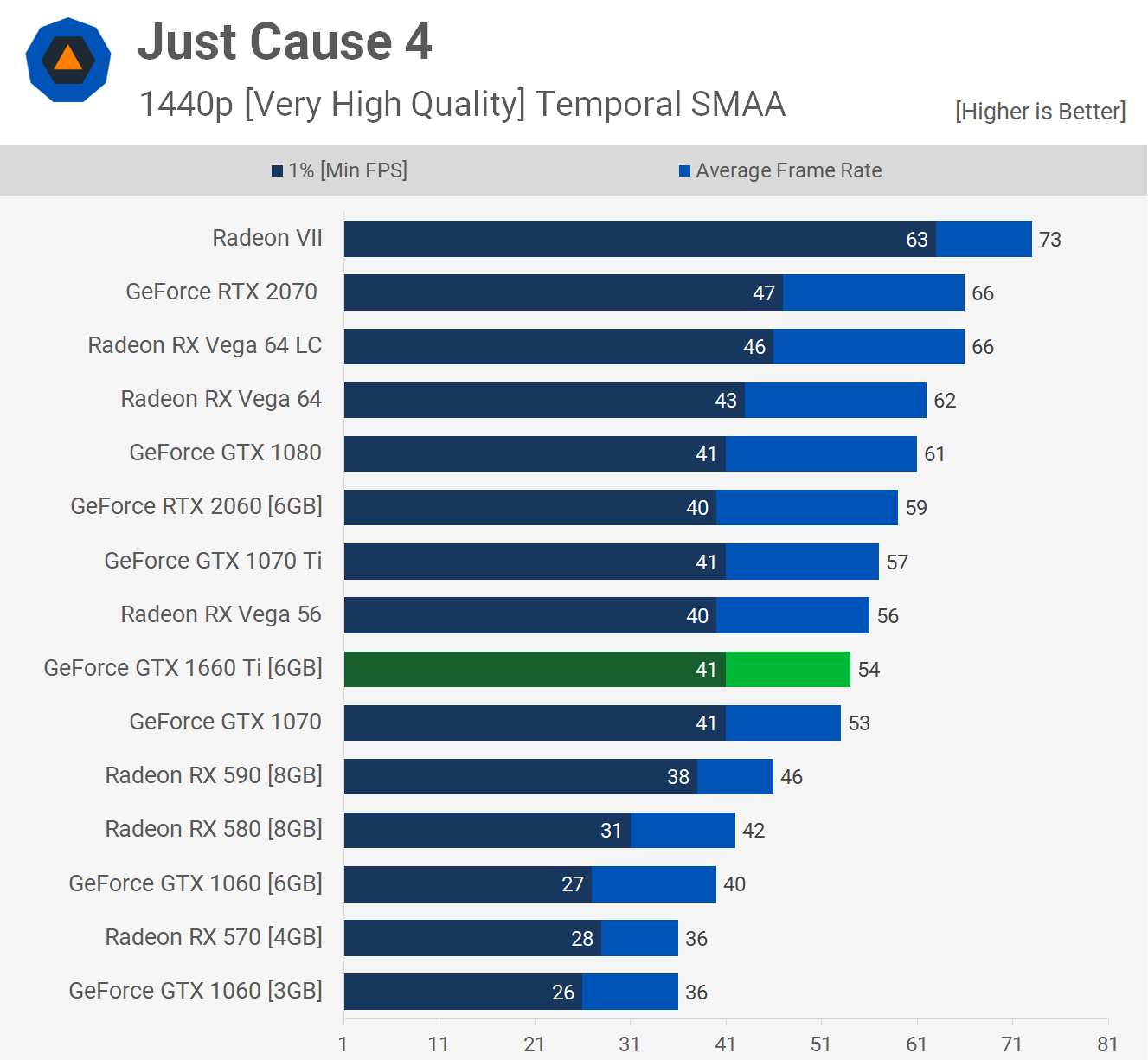
The GTX 1660 Ti slayed Resident Evil 2 with an impressive 108 fps on average, this placed it between the 1070 and 1070 Ti, so a solid result there. It maintained this position at 1440p and in a strong title for AMD it was still 11% faster than the Radeon RX 590, so another very solid result for Nvidia's new sub $300 GPU.

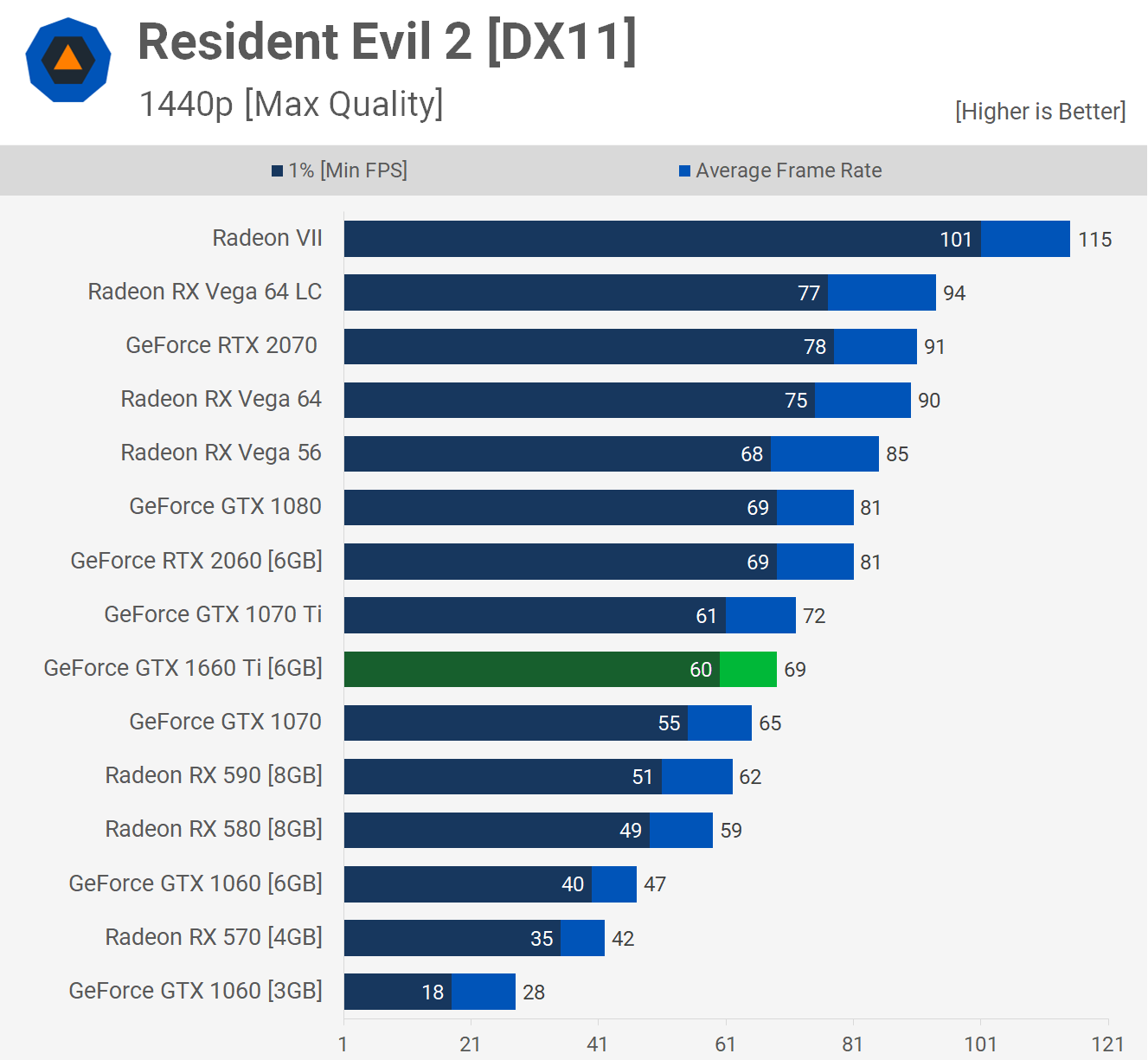
Hitman 2 is a bit odd at 1080p because we're CPU bottlenecked at this resolution. Moving to 1440p gives us a better idea of how these GPUs compare and here we see the 1660 Ti roughly matching the GTX 1070, making it just 12% slower than the RTX 2060.
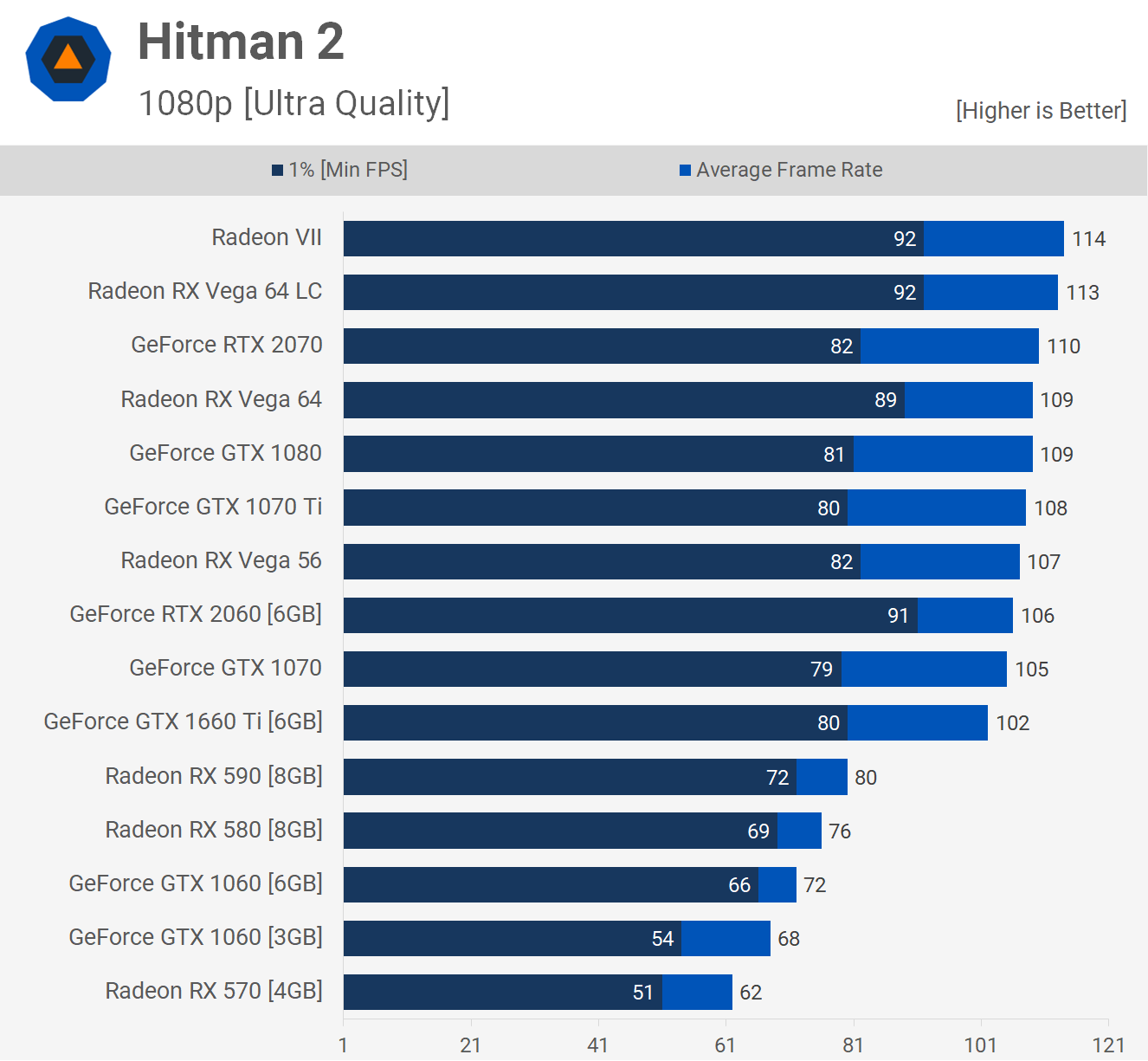
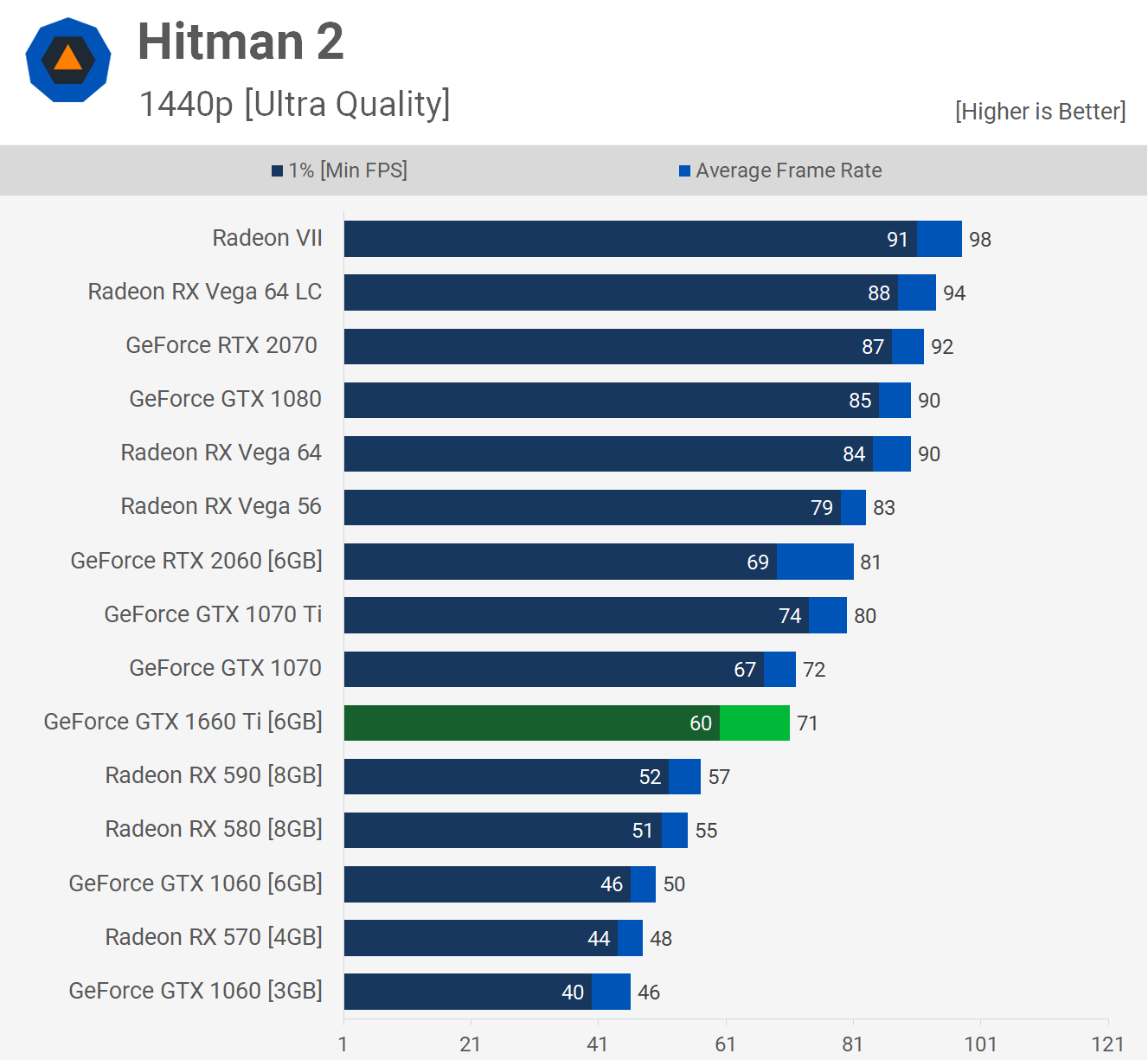
The GTX 1660 Ti is no doubt going to be a popular choice amongst Fortnite players, it's by far the cheapest way to push well past 100 fps using high quality settings. It also proves very capable at 1440p, pushing well over 70 fps throughout our test run. Once again, you're looking at GTX 1070-like performance.

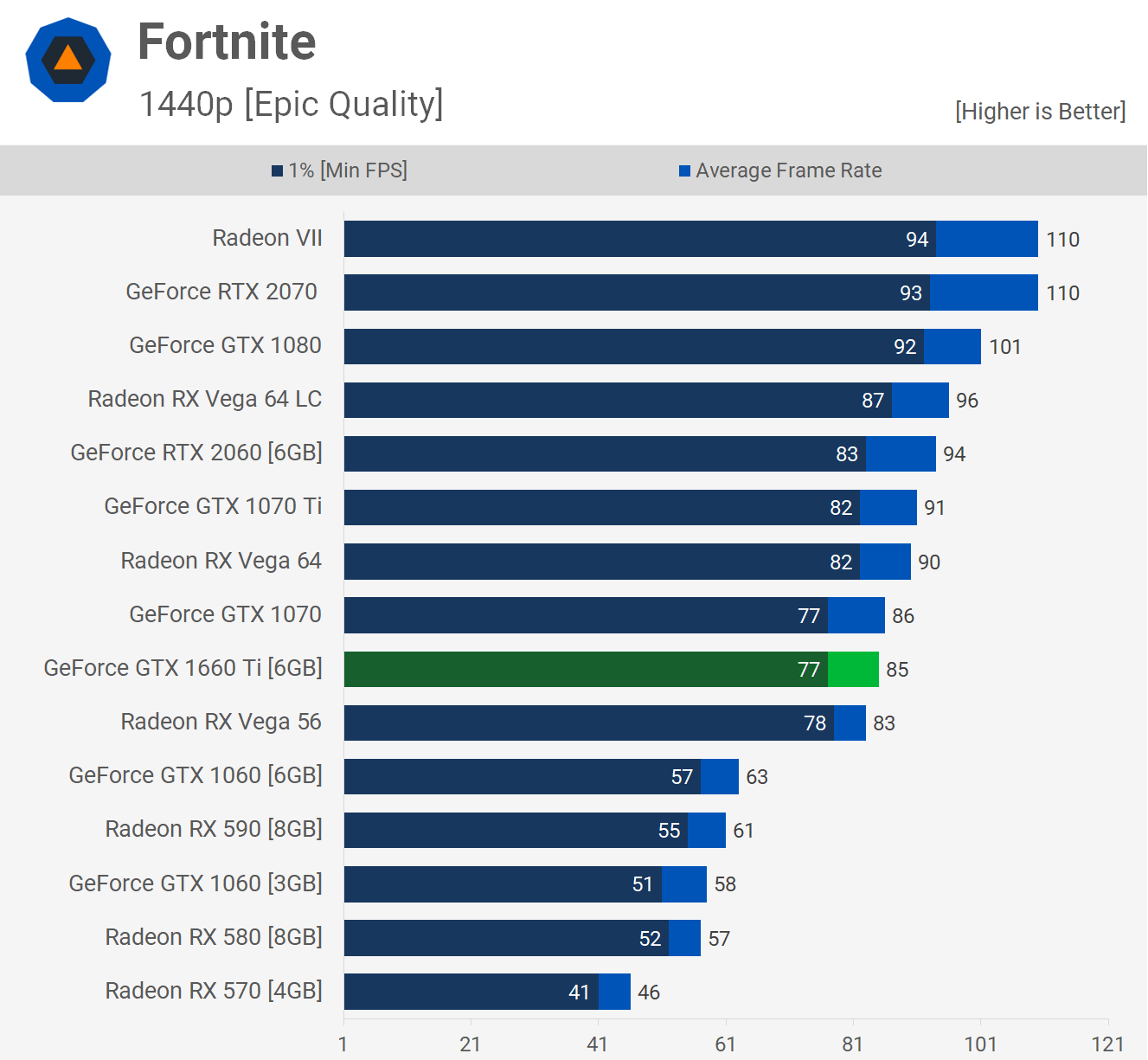
Metro Exodus is an exciting new game that we've already covered in-depth, but obviously this is the first time we've tested it with the GTX 1660 Ti. Performance at 1080p is respectable as is gaming at 1440p. On the latter, the 1660 Ti matches the 1070, making it 30% faster than the 6GB GTX 1060.
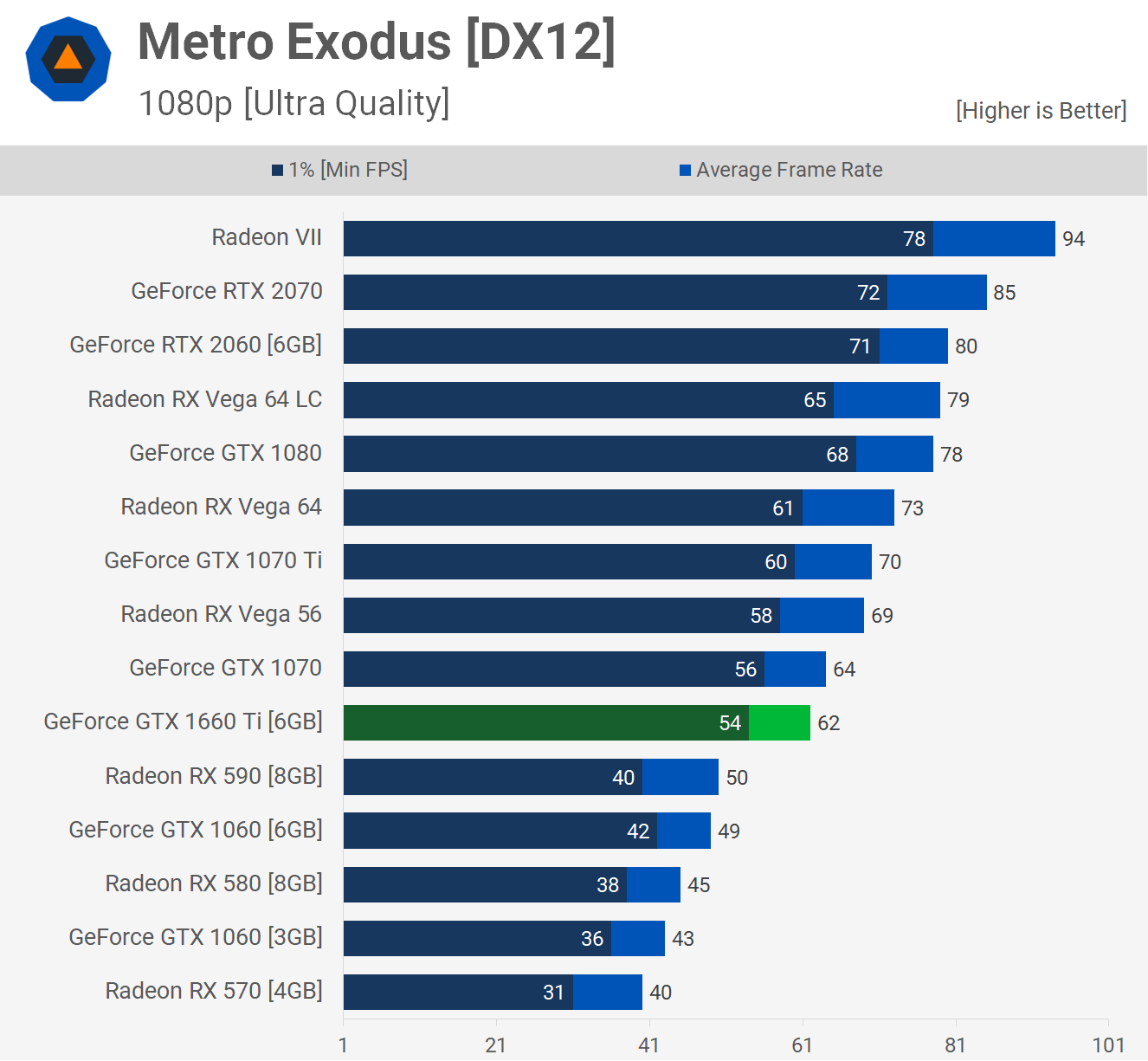
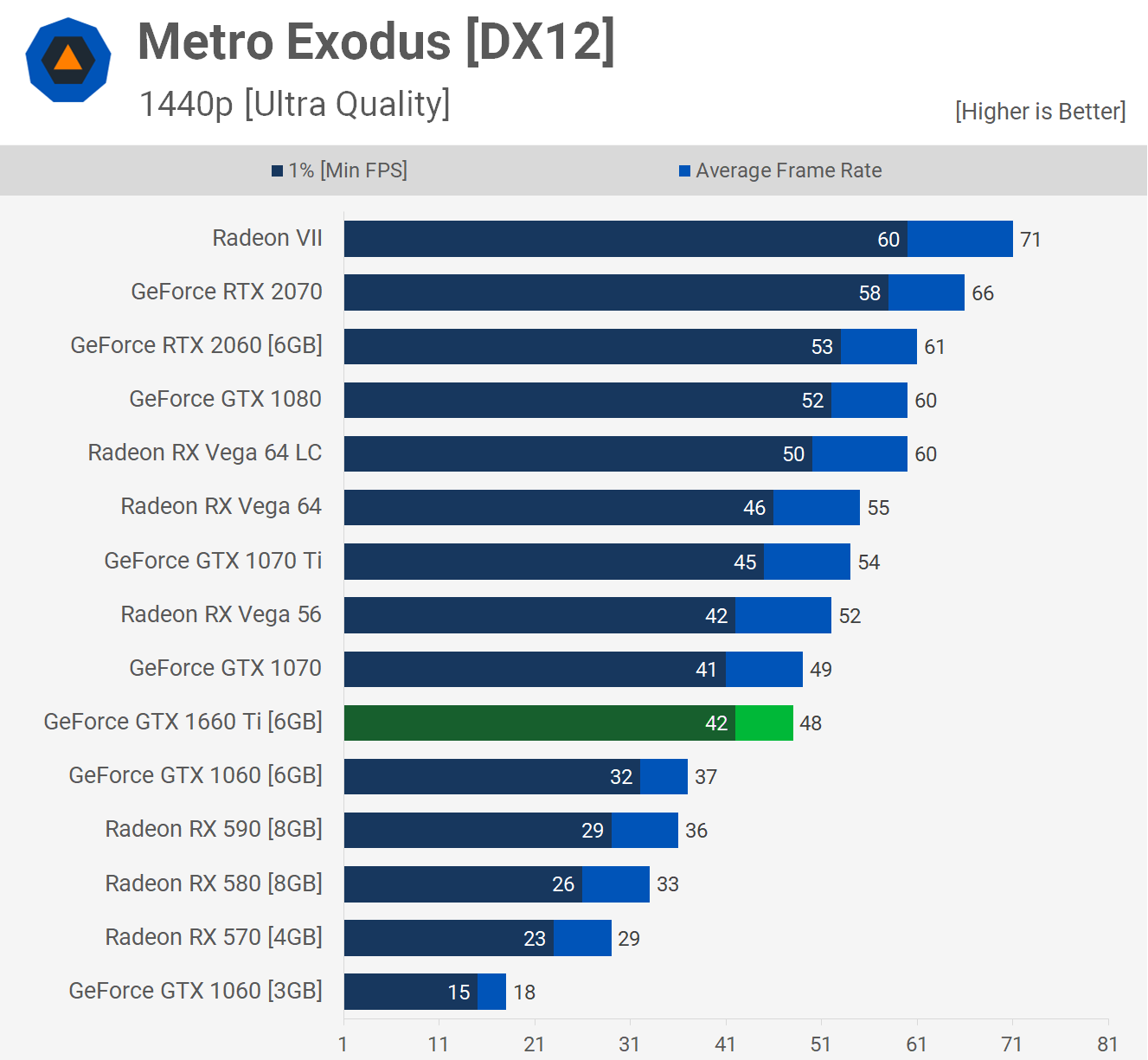
Rainbow Six Siege always provides us with interesting results and today's review is no exception. For the most part the GTX 1660 Ti has mirrored the GTX 1070's performance, but here it shatters it and manages to even edge out the GTX 1080.
Much the same is seen at 1440p, where the 1660 Ti matches the GTX 1080 making it 16% faster than the 1070 and 58% faster than the 1060 6GB, while it was just 2% slower than Vega 56.
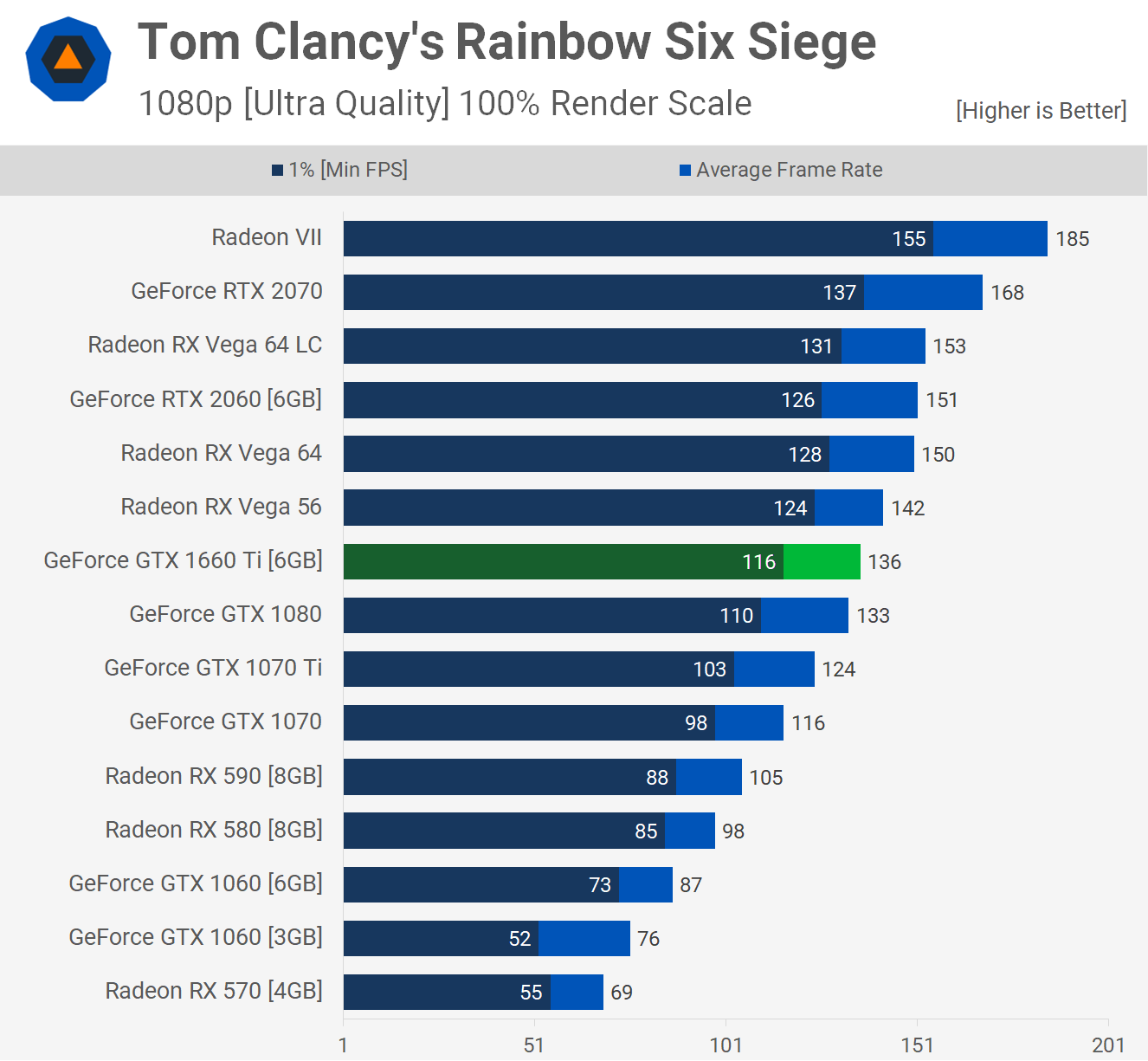
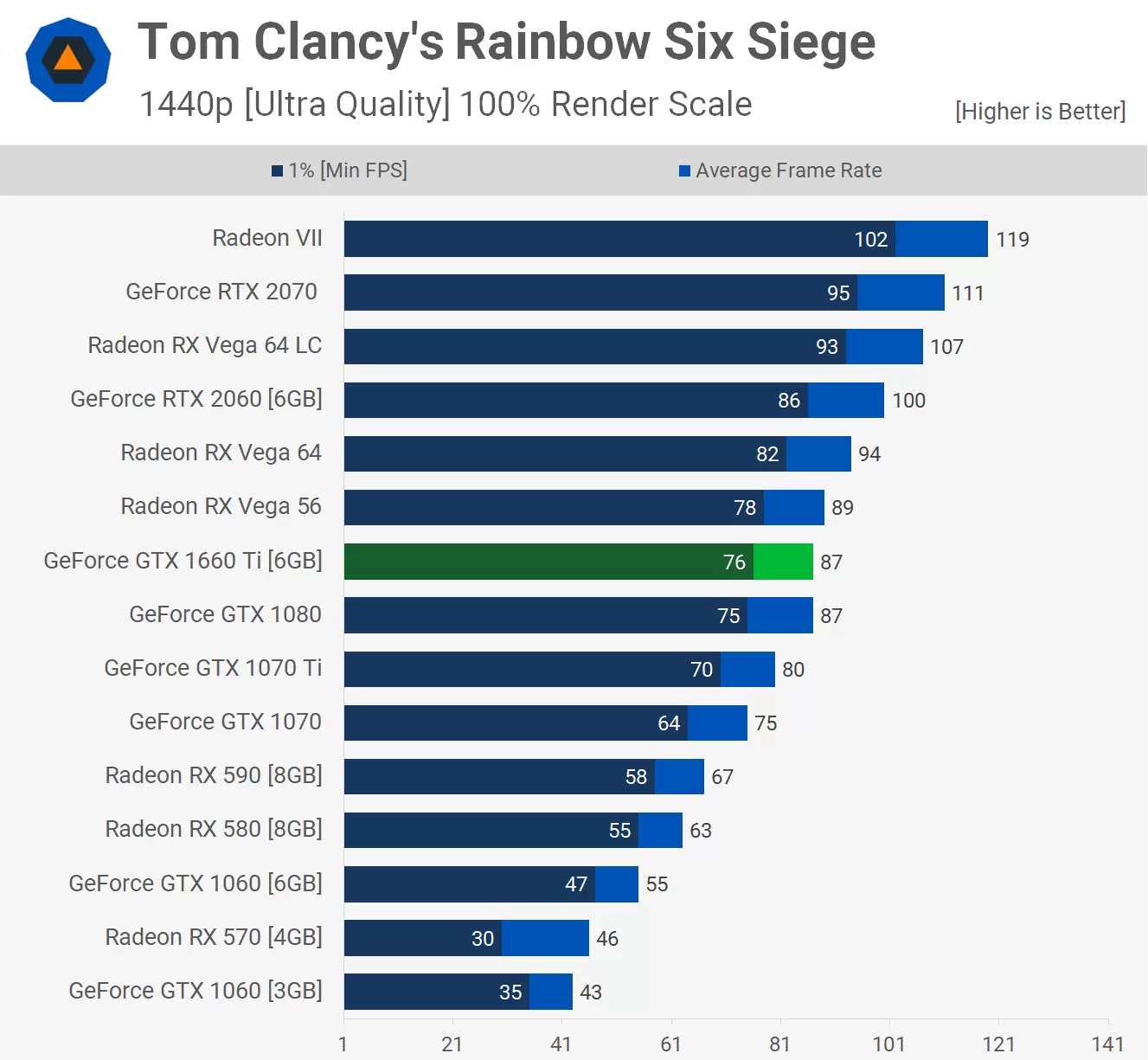
Our updated Battlefield V testing saw the GTX 1660 Ti come in just behind the GTX 1070 at 1080p, but with 90 fps on average it was a good step up from the GTX 1060. Then at 1440p we see much of the same. There the 1660 Ti was slightly slower than the GTX 1070, though with just 2fps in it, you could comfortably say they provided the same experience. Not only that, but with over 60 fps rendered during our test, the 1660 Ti provided highly playable performance in Battlefield V at 1440p.
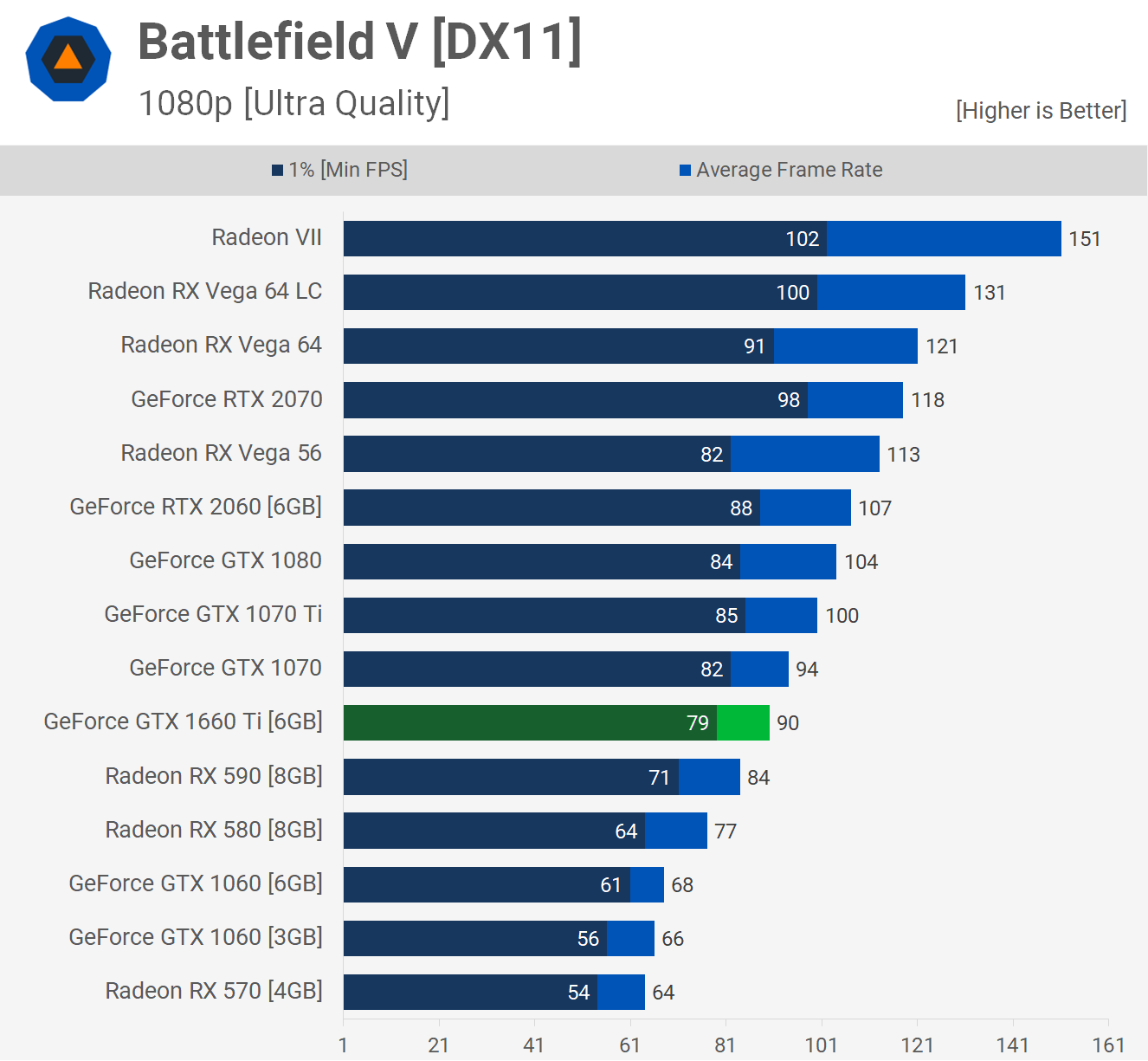

Interestingly the GTX 1660 Ti was unable to match the GTX 1070 in World of Tanks at 1080p, where it was 7% slower. A rare result from the new Turing GPU coming in behind the 1070. It did manage to beat Vega 56 however, and was almost 40% faster than the RX 590.

At 1440p we see very similar results. Vega 56 creeps ahead for the average frame rate, but is down for the 1% low result. Still at 35% faster than the Radeon RX 590, the 1660 Ti more than gets the job done.
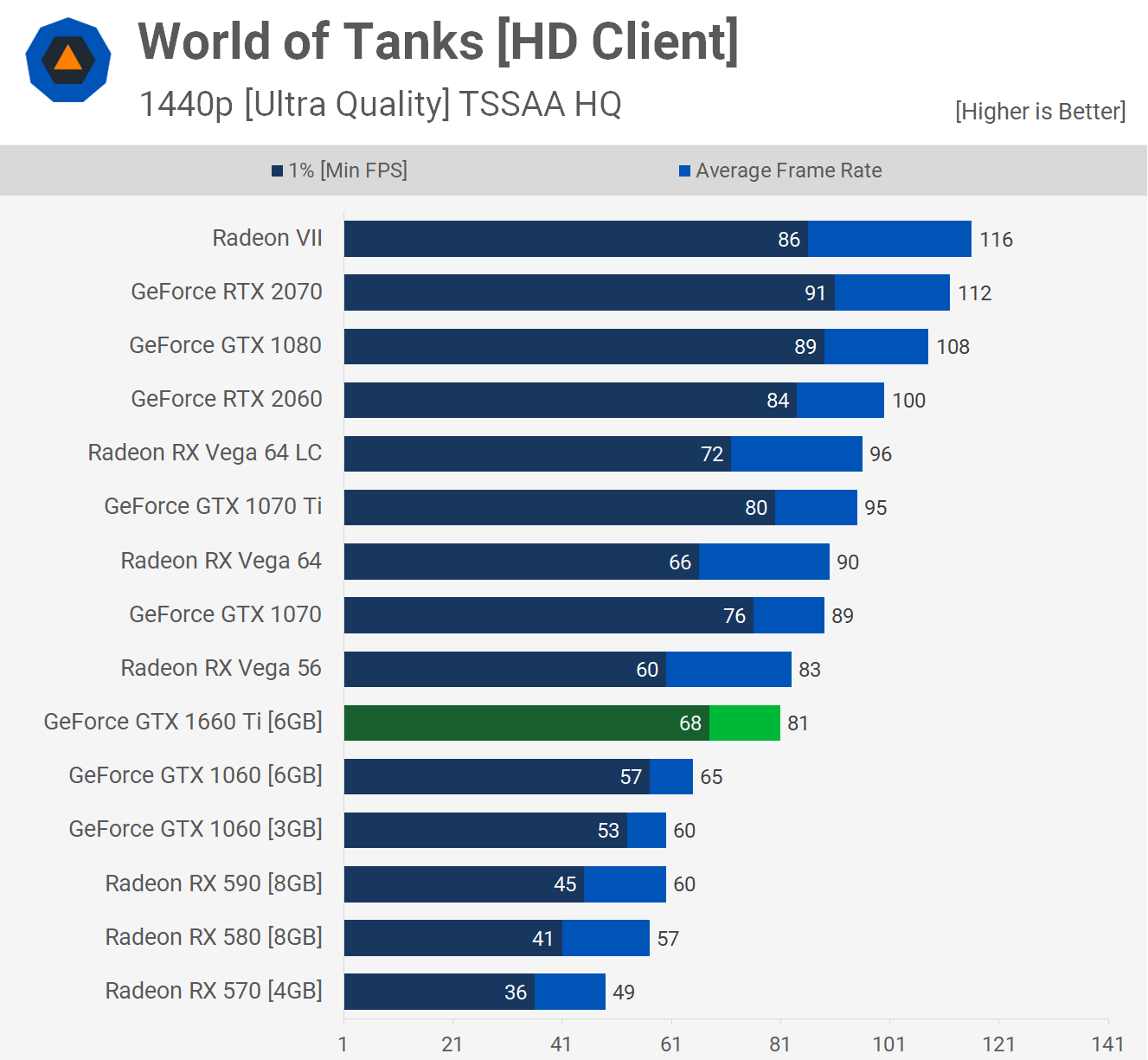
As the new ultra popular battle royale title in town, we've tested Apex Legends with the new GTX 1660 Ti. The card spat out 123 fps at 1080p, making it a whisker faster than Vega 56 and a whisker slower than the GTX 1070 Ti. It was also 16% slower than the RTX 2060.
Moving to 1440p, the 1660 Ti is found positioned between the 1070 Ti and Vega 56 making it 9% faster than the vanilla 1070 and 55% faster than the 6GB GTX 1060.
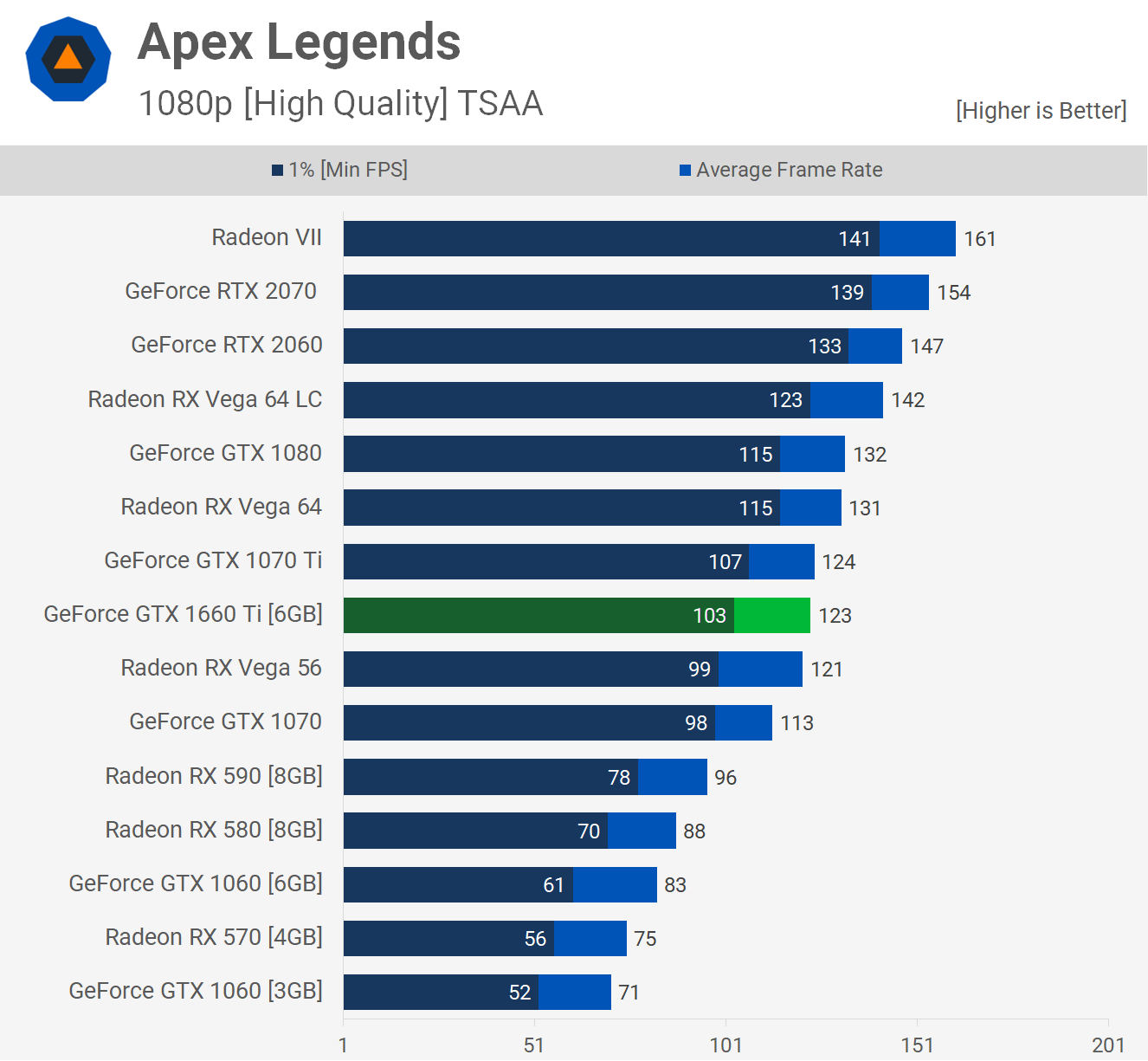
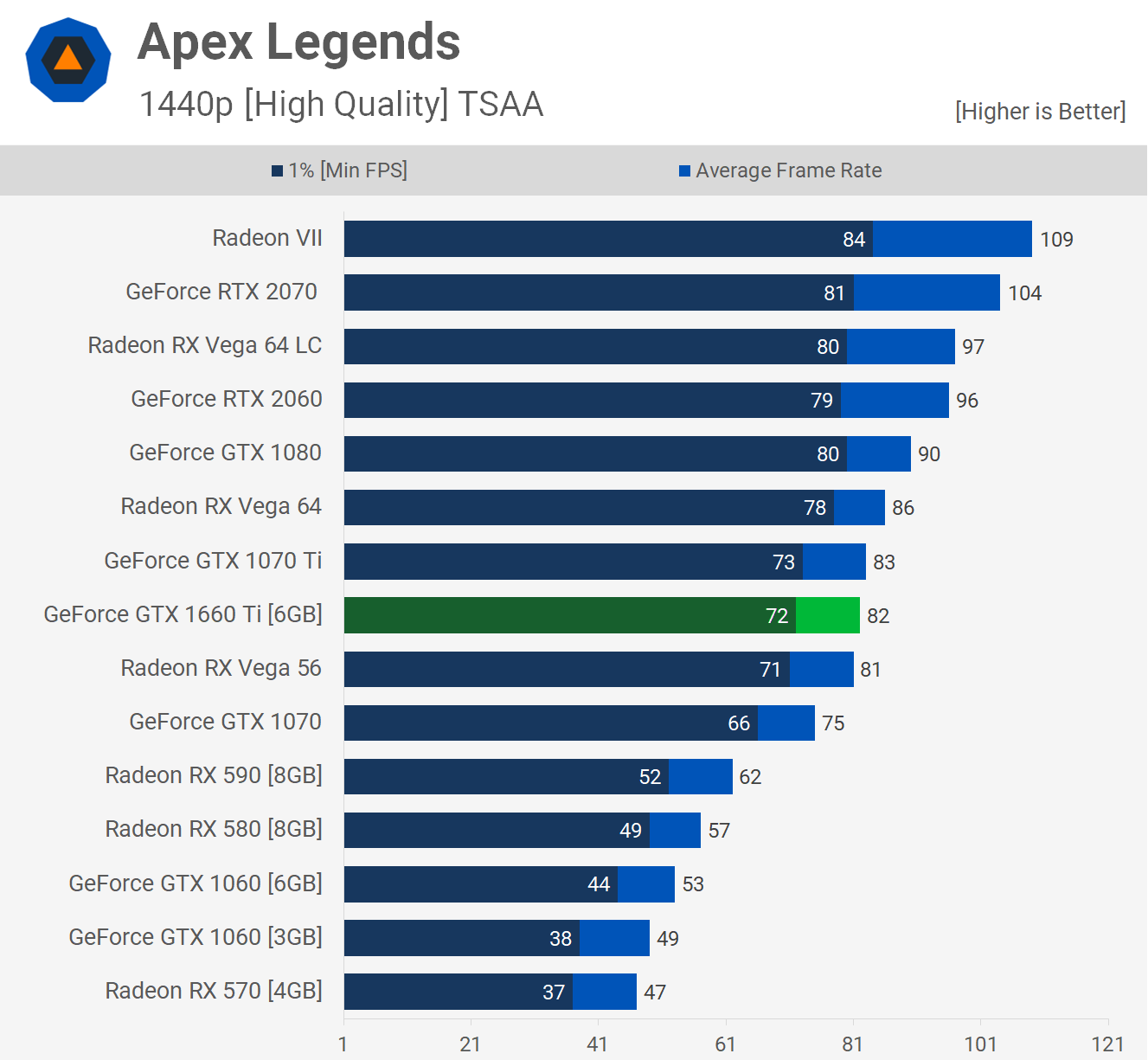
Wrapping up the game benchmarks we have the new Far Cry title: New Dawn. The results are similar to what we saw in Far Cry 5, which is to be expected since it's the same world and game engine. Here the 1660 Ti matches the GTX 1070, making it a little slower than Vega 56.
Then at 1440p as we've seen numerous times already, the margins remain the same.
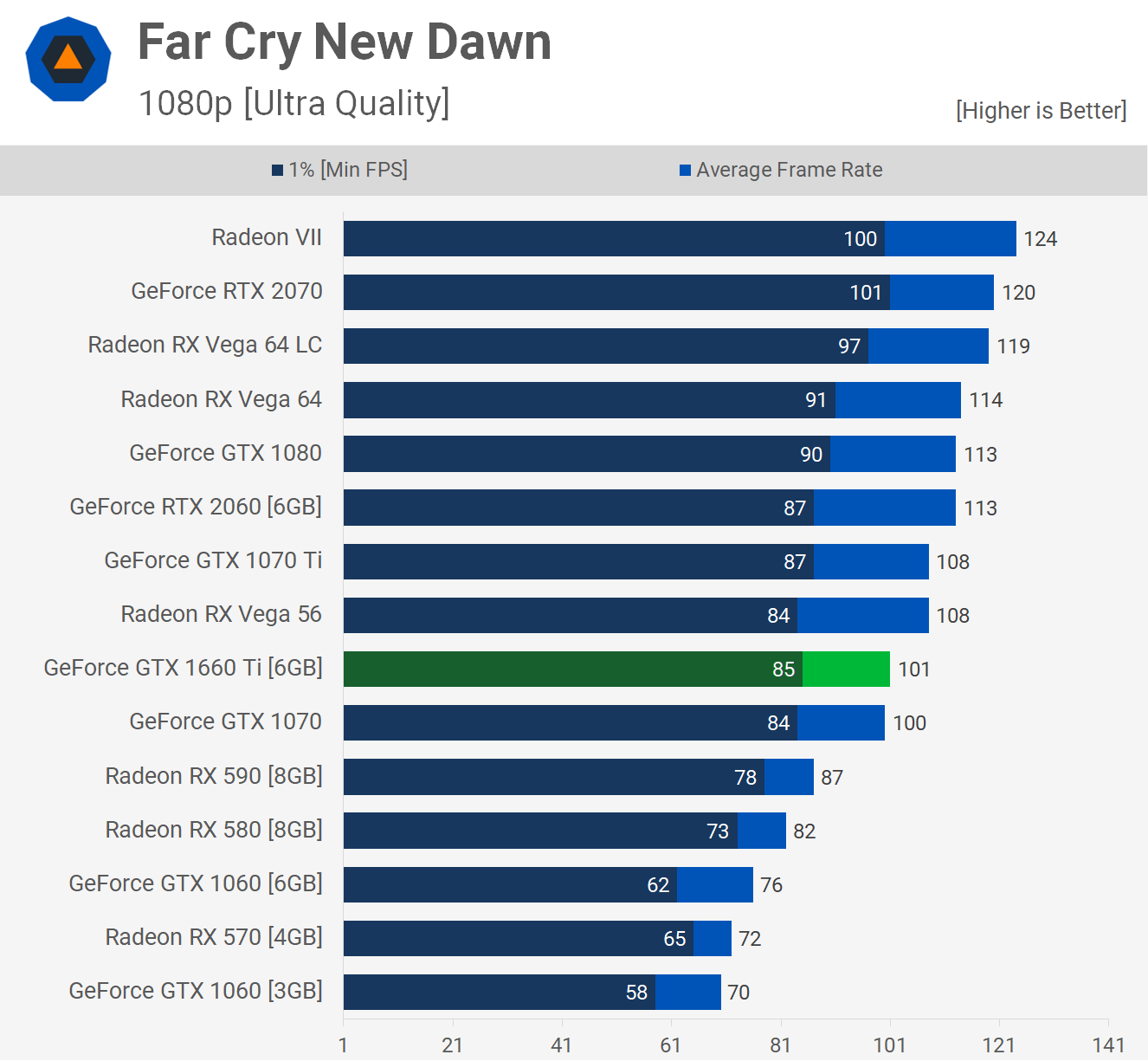
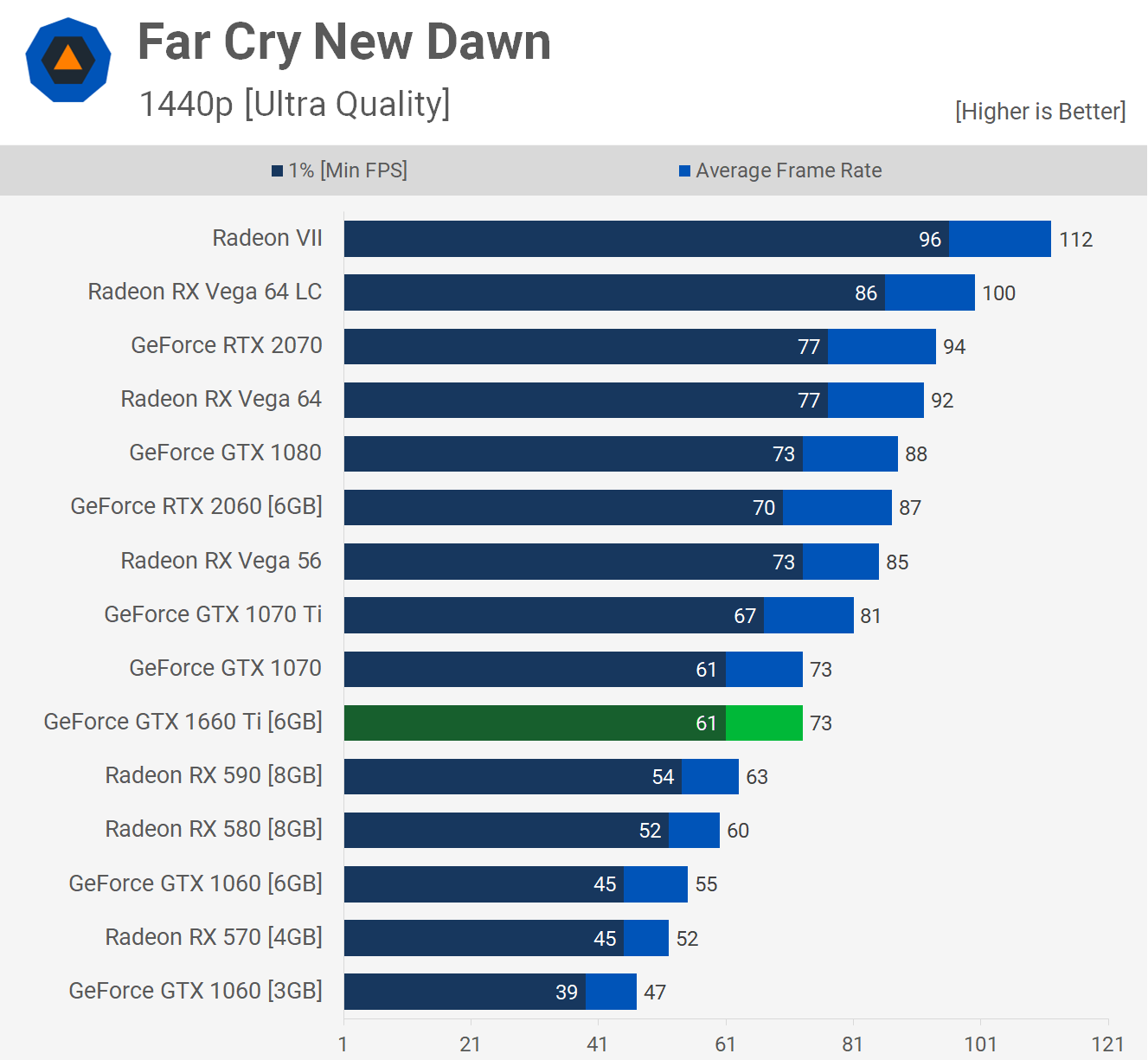
Power & Temperatures
When it comes to power consumption the GTX 1660 Ti pushed total consumption to just 271 watts making it very efficient. In essence you're getting GTX 1070-like performance for an 8% power saving for the total system.
We're not going to bother comparing that result with Vega 56, you can see the difference for yourself, plus Vega 56 has to be modified before it can be placed in a power graph like this, you know, standard out of the box stuff like undervolting until it's running on lemon juice. But in all seriousness, this is what you can expect from Vega 56 and 64 out of the box, same goes for Radeon VII.

As for operating temperatures, the MSI GTX 1660 Ti Gaming X we used was whisper quiet, even after an hour of heavy load. The fans only spun up to around 1500 RPM and this allowed for a peak GPU temperature of 66 degrees in a 21 C room. Very impressive stuff from this relatively small graphics card.
Overclocking
Even when overclocked, the 1660 Ti maintained basically the same operating temperature and fan speed, running just a single degree warmer. The operating frequency was only boosted by 4% on average, but we were able to massively overclock the memory speed, increasing the data rate from 12 Gbps to 15 Gbps, the maximum speed MSI AfterBurner would allow us to hit.
This boost combination allowed for an 8% performance increase when testing with Far Cry New Dawn. It's not exactly mindblowing stuff, but that's a pretty typical overclock for a modern Nvidia graphics card.

Individual Matchups
We've got a pretty good idea of how the new GeForce GTX 1660 Ti performs out of the box, how hot the MSI Gaming X runs, how well it overclocks, and how efficient it is. But how about we now check out exactly how the GPU stacks up against the GTX 1060, 1070, RTX 2060, Radeon RX 590 and Vega 56? Let's do that...
GTX 1660 Ti vs. GTX 1060
The GTX 1660 Ti is actually a decent upgrade over the GTX 1060 6GB, at least it can be depending on the title. On average it is 38% faster at 1080p and 40% faster at 1440p, and that right there is a big performance boost and certainly justifies spending $280 in our opinion. Especially if you want to delve into 1440p gaming.
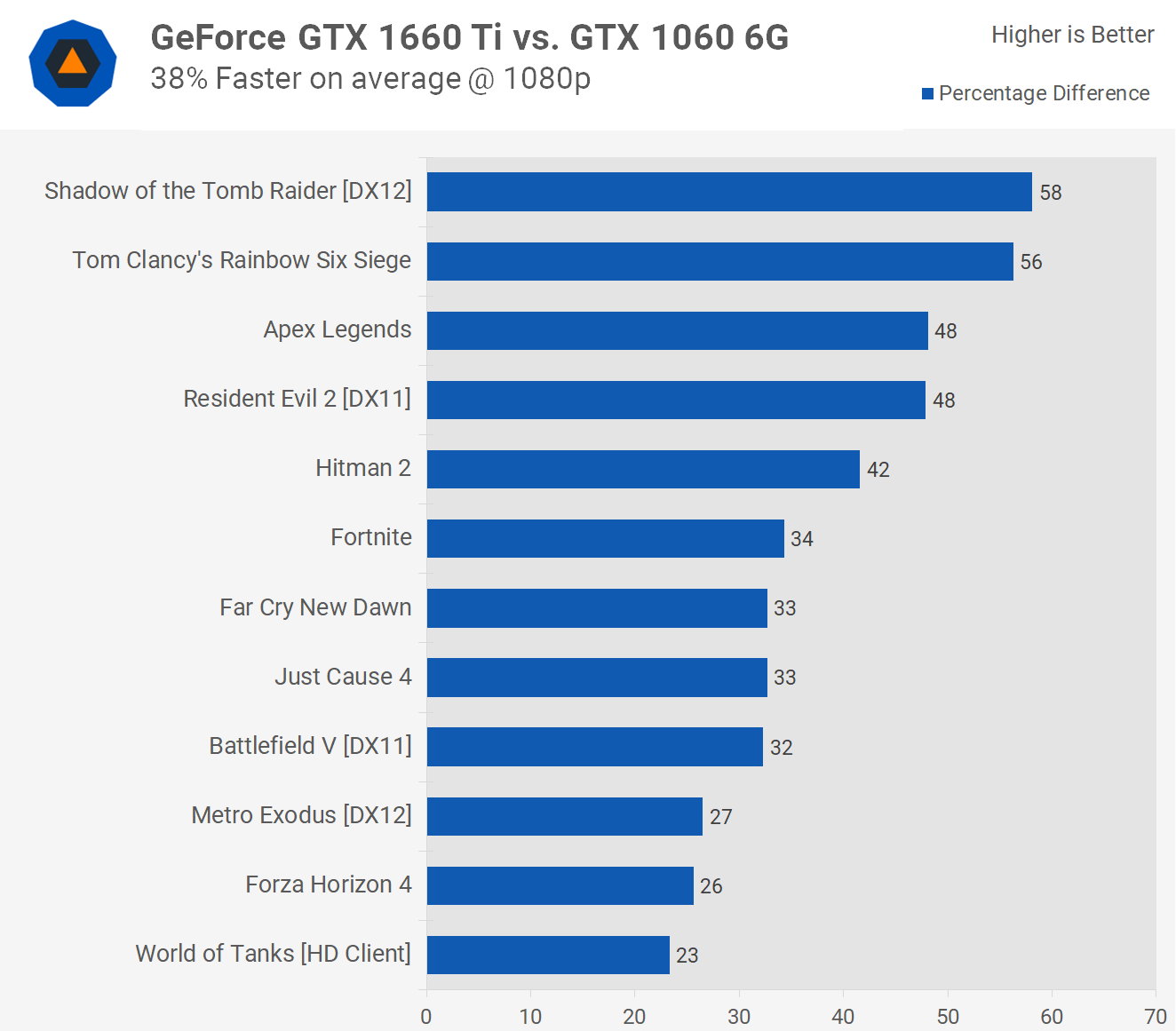
Upgrades aside, you wouldn't even entertain purchasing a GTX 1060 6GB anymore. We mean, you shouldn't have as the RX 580 is much better value. Anything north of $200 and we wouldn't give it a second look.
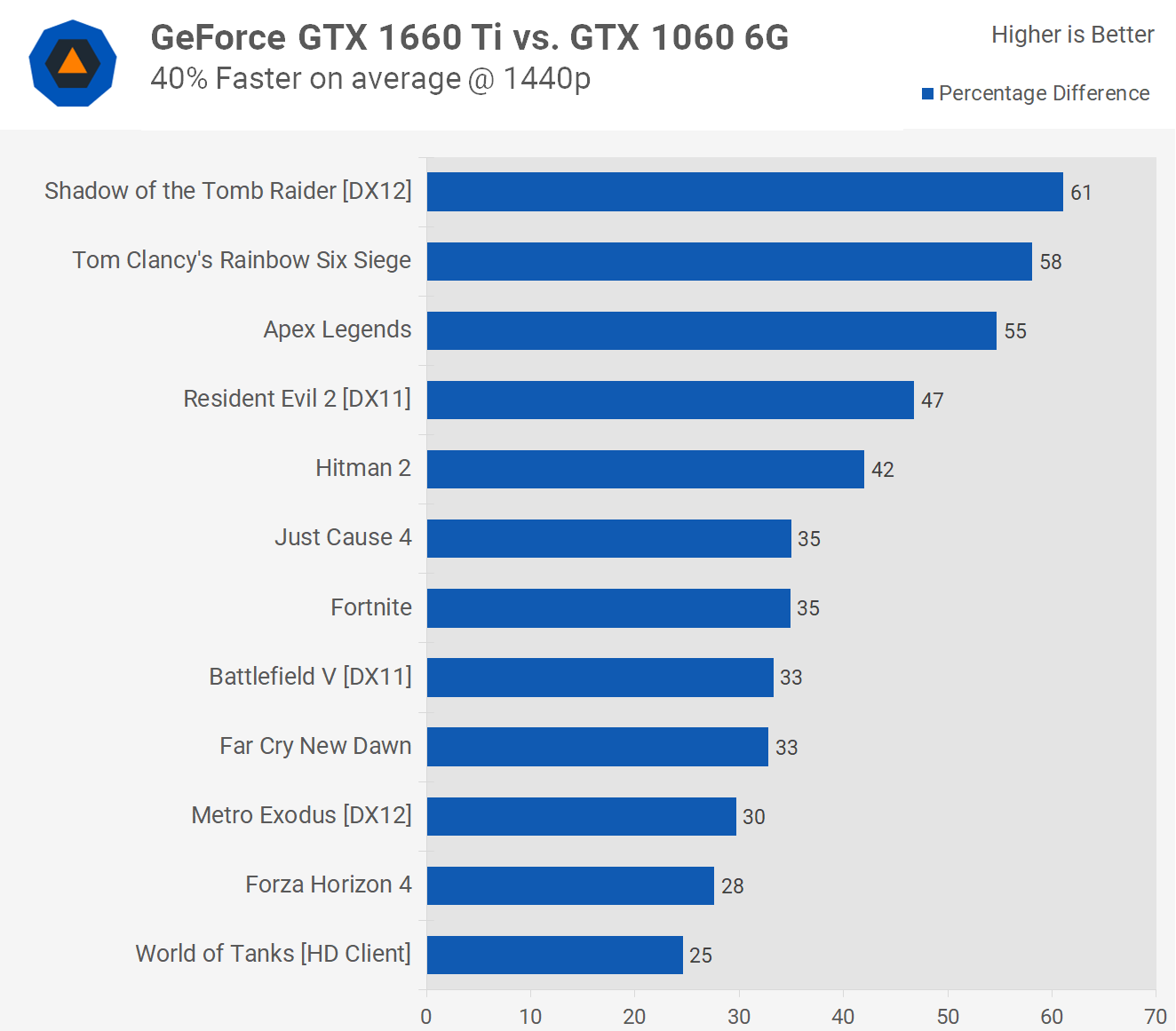
GTX 1660 Ti vs. GTX 1070
This one we called it throughout the review and benchmark results, so you know the GTX 1660 Ti is kind of the new GTX 1070. Performance does vary a bit in a few titles, but for the most part we're looking at a single digit performance difference. We see the same 2% performance difference at 1440p.
The 1660 Ti performed well in Rainbow Six Siege, Shadow of the Tomb Raider and Apex Legends, but as we said overall performance was much the same.
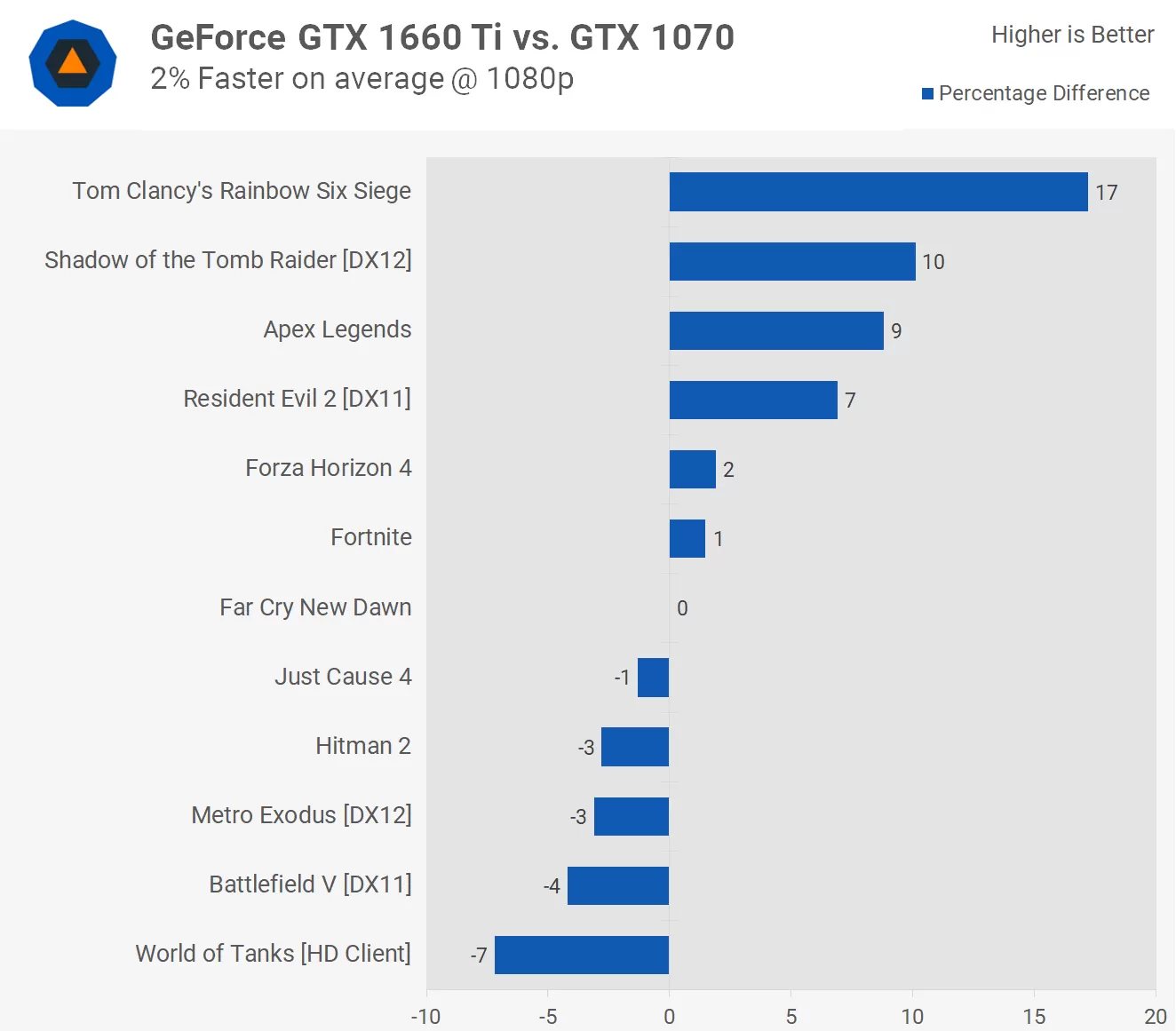

GTX 1660 Ti vs. RTX 2060
It's interesting to note that the GTX 1660 Ti is 20% cheaper than the RTX 2060, but at 1080p is just 12% slower. You could of course argue that the 2060 is better value because of those RT and Tensor cores that enable ray tracing and DLSS, but we'd scoff at such a claim. The 1660 Ti was also just 12% slower at 1440p.

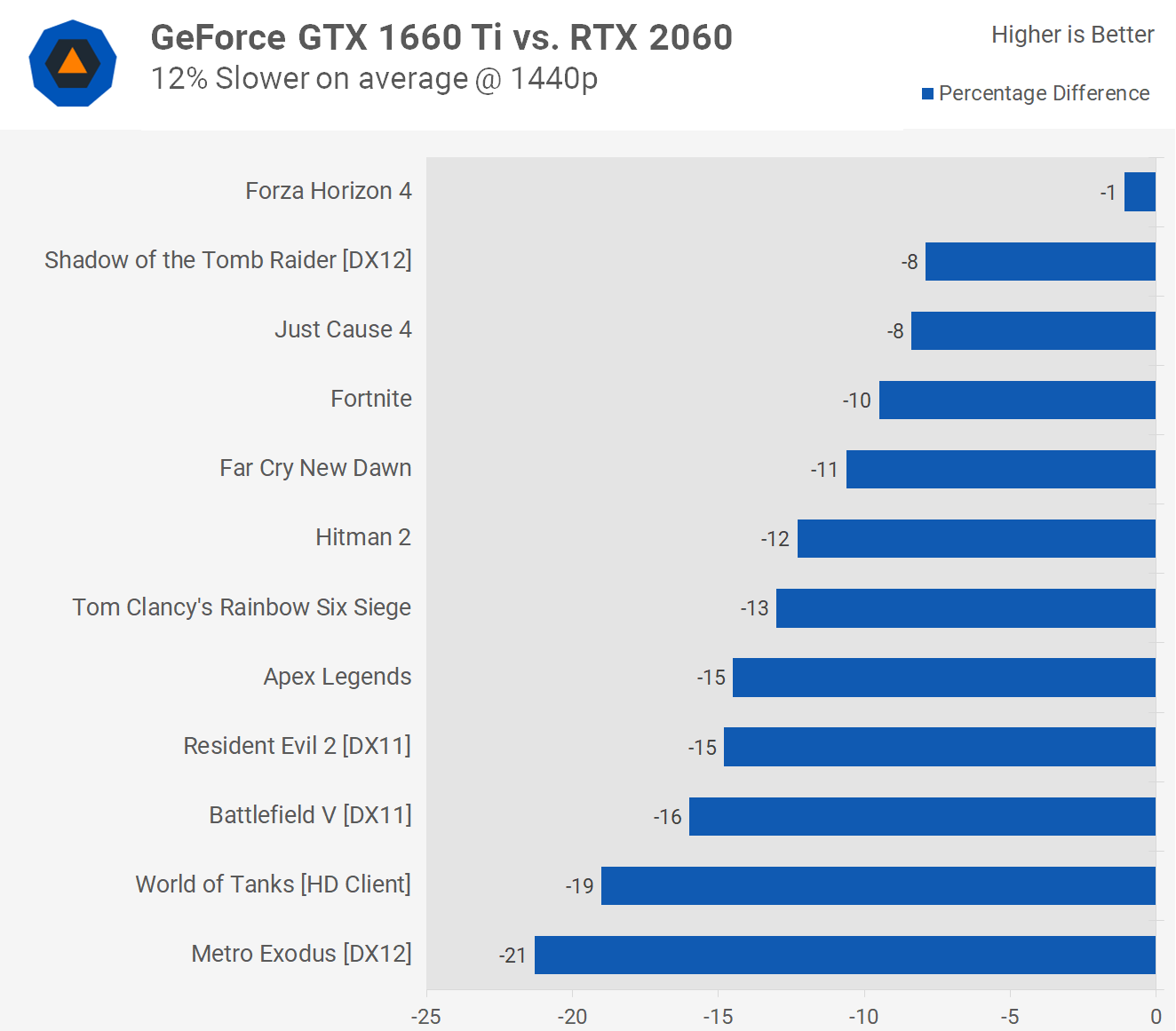
GTX 1660 Ti vs. Radeon RX 590
Compared to the similarly priced RX 590, the GTX 1660 Ti is a full 24% faster.
Since we reviewed the RX 590, we said the pricing for that GPU was not right and was not a good value, but now AMD will be forced to make adjustments. The new 1660 Ti gets you 24% more performance for an 8% price hike. Not only that, but in the worst gaming scenario the 1660 Ti was still 7% faster than the RX 590, while in the best case up to 46% faster. So it's clearly the better buy.
Expect further RX 590 price drops now that the 1660 Ti is on the scene. The margins we just described were maintained at 1440p, where the 1660 Ti was ~25% faster on average.

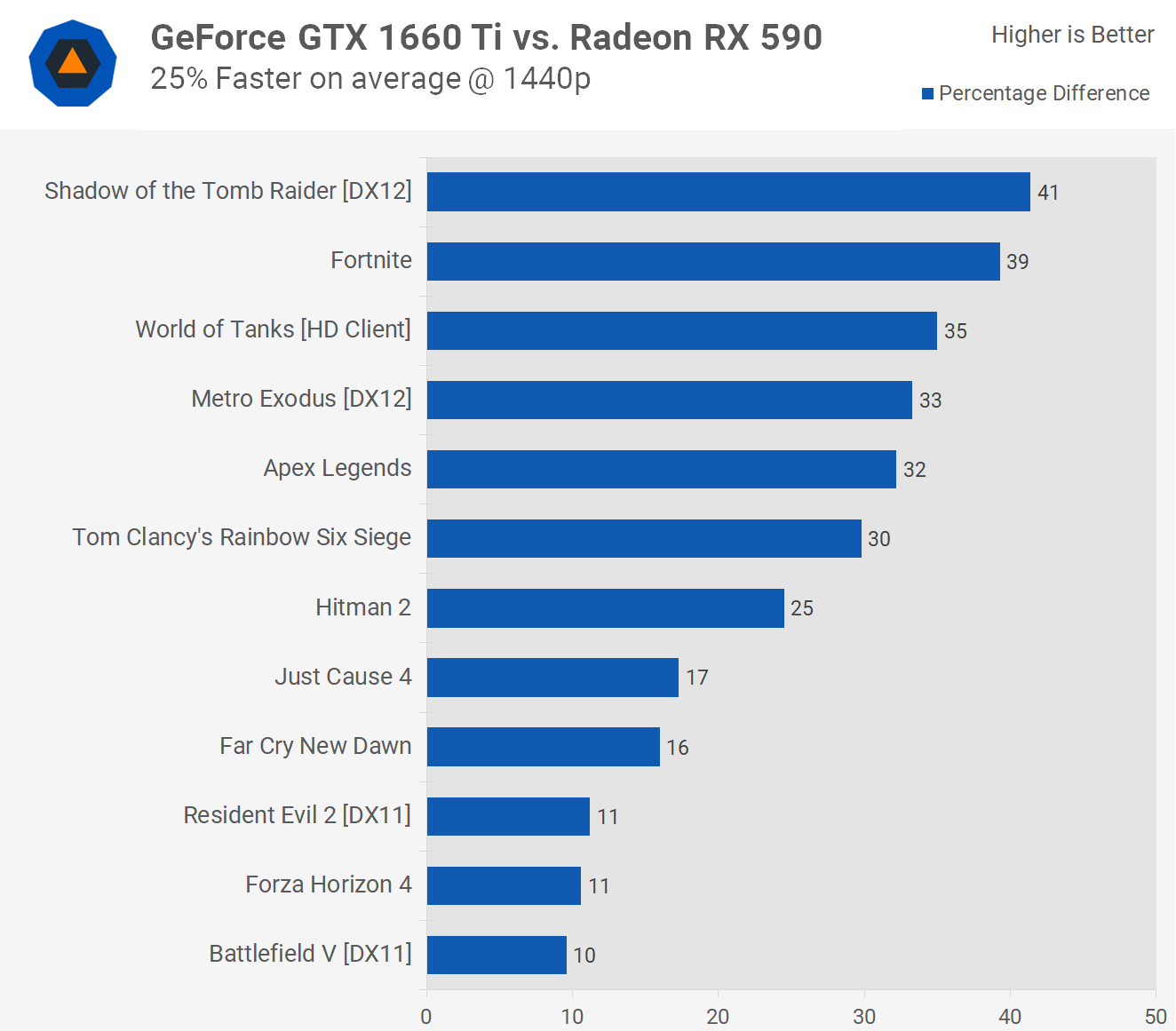
GTX 1660 Ti vs. Vega 56
Finally we have Vega 56 which typically sells for $400, with the crazy sale here and there dropping it down closer to $300. The GTX 1660 Ti was 7% slower on average and even if Vega 56 was to sell at $330 (the last deal we saw recently), the 1660 Ti would still be 15% cheaper, making it the better value overall. Not to mention, much more efficient.
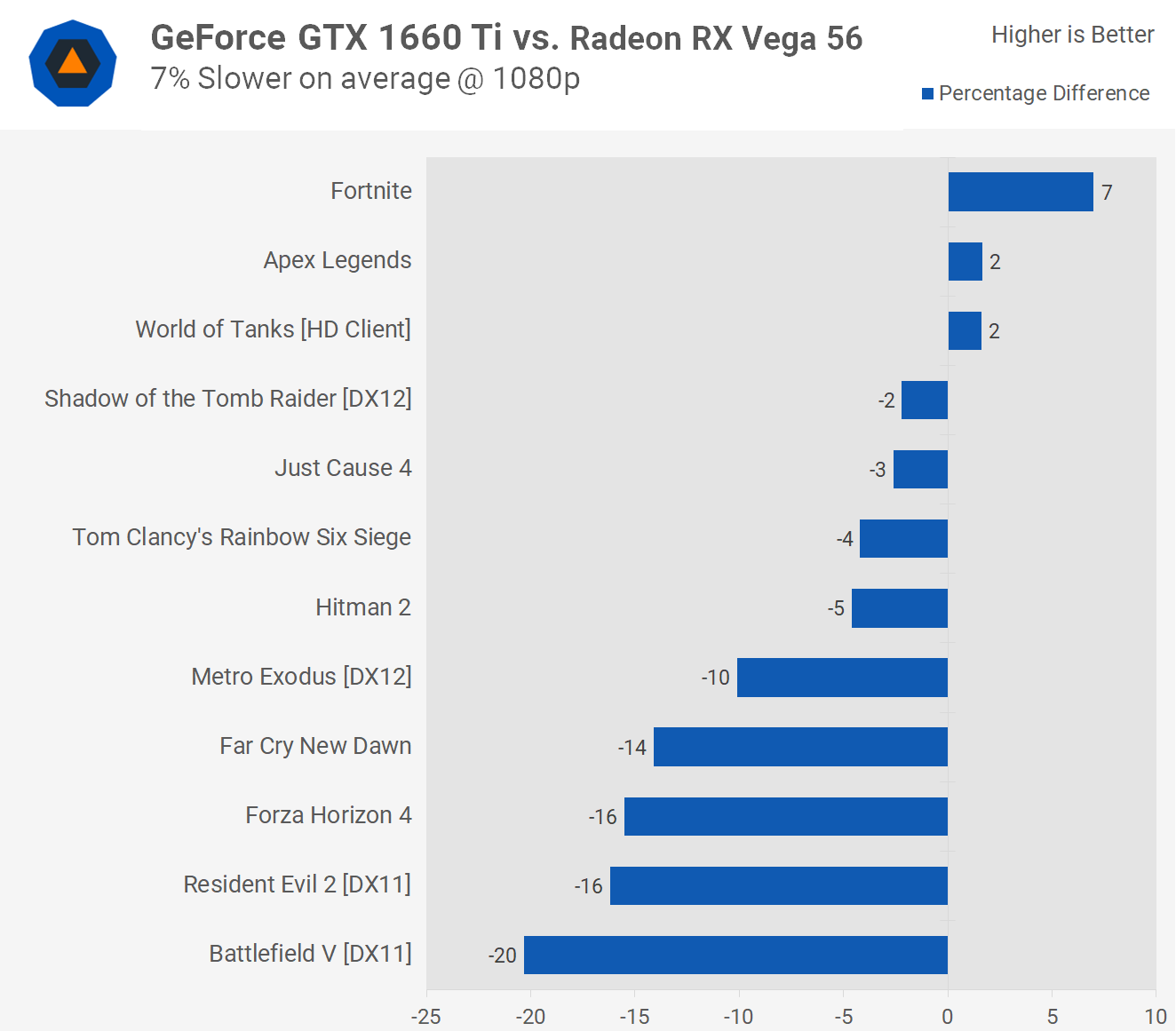
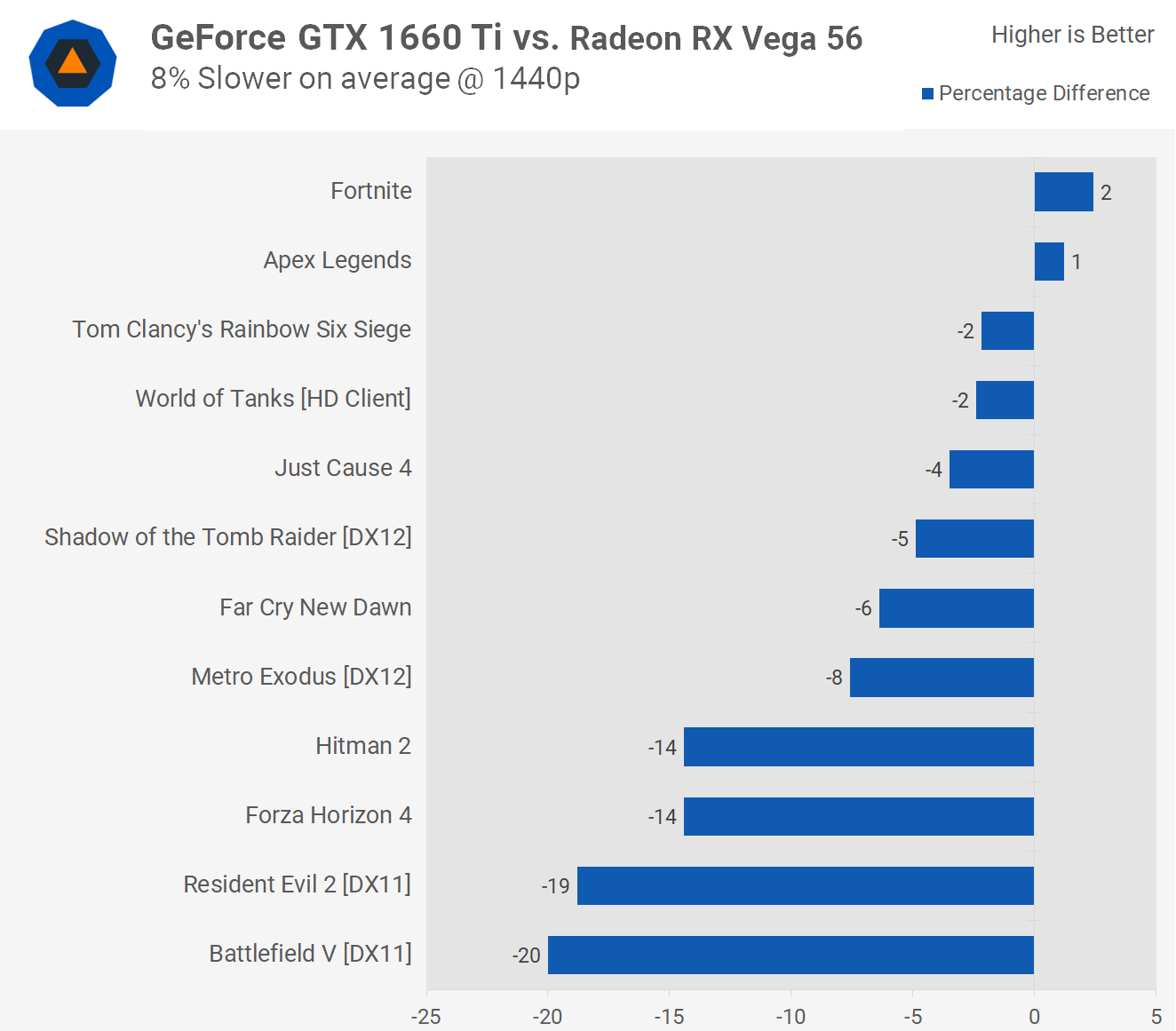
Cost per Frame and Conclusion
With everything we've just seen, you'd expect the GTX 1660 Ti to fare well in the value department and it does. Basically you're looking at a similar price-to-performance ratio as the Radeon RX 580, which is incredibly good news for gamers.
The GeForce GTX 1660 Ti is an entire tier above the RX 580, so for this GPU to deliver a similar cost per frame is simply great.

With a similar level of performance to that of Vega 56, the GTX 1660 Ti comes out at a saving of 25% per frame. It is also 19% more cost effective than the GTX 1060 6GB. The least impressive comparison can be made with the RTX 2060, here it was just 9% more cost effective, which is still an impressive margin and I'll talk more about this in a moment.
The first Turing GPUs were released last September, and in our opinion it wasn't until Nvidia released the RTX 2060 that we got a well rounded model worth buying. To be fair the RTX 2080 Ti is an incredible beast and we love gaming at 4K with it, but it's also stupidly overpriced at $1300. For a wide majority of gamers, it's not that good.
The RTX 2080 was a snooze fest at launch, particularly because it was selling well above the MSRP. Today it's definitely better. The RTX 2070 meanwhile is far worse off, as it was effectively eliminated by the 2060 just three months after release. Then for those that hadn't yet nodded off, AMD chimed in with some elite level ASMR with their Radeon VII...
The GTX 1660 Ti may be the first GPU release in a while that we've come away feeling completely pleased. We're getting GTX 1070-like performance for a slight price premium over the GTX 1060 6GB, and while many would have prefered pricing set at $250, without any competition from AMD at the moment we think this is a pretty good result.
Speaking of AMD, the 1660 Ti puts them in a tough spot. Previously the RX 580 was the obvious sub-$300 option, but now the choice is more difficult and frankly we'd go for the 1660 Ti. It's $80 more but offers higher tier performance. In today's games the RX 580 is more of a 1080p solution, whereas the 1660 Ti can be used for high refresh rate 1080p gaming or 1440p gaming. It's also much more efficient and we expect all cards to run cool and quiet. Fingers crossed AMD can pull a rabbit out of their hat with Navi later in the year, that would certainly benefit us all.
In the meantime though, the GeForce GTX 1660 Ti is the new sub-$300 king, and we are not at all concerned by the lack of RT and Tensor cores. Frankly, we'd much rather have a GTX 2080 Ti with some extra CUDA cores... we'd certainly be more compelled to spend $1300 on that.
The only question remaining is, how much will you have to pay to get a new GTX 1660 Ti? As it often happens, pricing will likely be all over the place during the initial few weeks, but with the RTX 2060, 2070 and 2080 all selling at the MSRP, we expect the same will be true for the GTX 1660 Ti before long.
